Preserving legacy and land

Honouring Irish roots at countryside escape
The vital role of co-operatives in farming communities
Dark winter for science funding
Ruralco Instore Days 2024 30th anniversary



Honouring Irish roots at countryside escape
The vital role of co-operatives in farming communities
Dark winter for science funding
Ruralco Instore Days 2024 30th anniversary

It’s that time of year again where we welcome warmer weather and longer days, and plan how to make the most of both on and off farm.
In the spring edition of Real Farmer, we recap on our 2024 Instore Days where we celebrated the 30th anniversary of the event which brings farmers and businesses from across the district together for two epic days—and how exciting it was for us to host the Prime Minister, enabling him to hear directly from local farmers. I’d particularly encourage you to read the article about the value of a Co-op. It’s no coincidence that we are your local farmers co-op, our primary focus is on supporting you as farmers. Talking about local, also check out the story about how local primary schools are putting some well-deserved extra funds from our Spend for Your School programme to good use. Looking after our local community is core to who we are, and this programme is one of the many ways that we deliver on that commitment.
We also venture out to one of Canterbury’s most scenic spots and catch up with Paul and Kerry Harmer at Castle Ridge Station, where they run 15,000 merino ewes, 800 Angus cattle, and 250 Red deer across nearly 6,000 hectares of farmland. We have a chat with Springburn dairy farmers Allan and Heather Broomhall, who have diversified their dairy operation and taken a dive into hospitality by adding a Canopy Camping cabin to their farm, offering city-livers a taste of farm life while they escape in the country. We also look at the impact declining funding is having on agricultural research within the country. Read these stories and more in the latest Real Farmer, where we share real stories about the people and businesses working in New Zealand’s primary industries.

Tony Aitken tony.aitken@ruralco.co.nz

RURALCO
PO Box 433, Ashburton 7740 0800 787 256 www.ruralco.co.nz
EDITORIAL ENQUIRIES:
Our team welcome your contributions, enquiries and letters.
Please email to: marketing@ruralco.co.nz
DISCLAIMER:
ADVERTISING ENQUIRIES:
Please contact the Marketing Department on: 0800 787 256 marketing@ruralco.co.nz
Views expressed by contributors are not necessarily those of Ruralco.
CONTRIBUTORS
Anita Body
Annette Scott
Annie Studholme
Indiana Roberts
Rachael Rickard
Richard Rennie
PHOTOGRAPHERS
Annie Studholme
Indiana Roberts
Sam Anderson
Richard Rennie
TECHNICAL ARTICLES
Adroit Solutions 027 224 3520 info@adroitsolutions.co.nz www.adroitsolutions.co.nz
Agricom 0800 787 256 ruralco@ruralco.co.nz www.ruralco.co.nz
Agritrade 0800 787 256 ruralco@ruralco.co.nz www.ruralco.co.nz
Barenbrug 0800 787 256 ruralco@ruralco.co.nz www.ruralco.co.nz
Beef + Lamb 0800 233 352 enquiries@beeflambnz.com www.beeflambnz.com
Cropmark 0800 787 256 ruralco@ruralco.co.nz www.ruralco.co.nz

DairyNZ 0800 4 324 7969 info@dairynz.co.nz www.dairynz.co.nz
FAR 03 345 5783 far@far.org.nz www.far.org.nz
Farmstrong info@farmstrong.co.nz www.farmstrong.co.nz
Federated Farmers 0800 327 646 0800@fedfarm.org.nz www.fedfarm.org.nz
FMG 0800 366 466 contact@fmg.co.nz www.fmg.co.nz
Irrigation NZ 04 595 6848 admin@irrigationnz.co.nz www.irrigationnz.co.nz
Ngahiwi 0800 787 256 ruralco@ruralco.co.nz www.ruralco.co.nz
RAGT 0800 787 256 ruralco@ruralco.co.nz www.ruralco.co.nz
SealesWinslow 0800 787 256 ruralco@ruralco.co.nz www.ruralco.co.nz
ON THE COVER:
Despite the unique challenges farming in the “sensitive lakes” area of the Ashburton high country brings, Castle Ridge Station owners Paul and Kerry Harmer remain passionate about the future and protecting their environment.



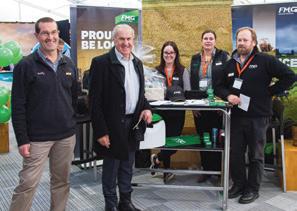



2 Preserving legacy and land
8 Honouring Irish roots at countryside escape
13 Growing with Canterbury: A family’s journey in electricity
18 Dark winter for science funding
20 Ruralco Instore Days 2024 30th anniversary
26 The vital role of co-operatives in farming communities
32 Investing in future generations through community support
41 90 years strong: Newlands Group introduces ARB 4x4 accessories
7 Strategies to prevent costly irrigator damage
15 Farmer confidence stubbornly low
25 RGT18: The new novel endophyte everyone is talking about
29 Revamp for 2024 Ruralco Longbeach Coastal Challenge
37 Wormwise advice for ewes and lambs this spring
39 Essential steps for protecting young stock
43 Introducing Align’s game changing resilience
49 Ngahiwi Farms: A legacy of excellence
51 Persistent yields with Stampede CM142
52 Wheat cultivar mixes show promise
59 Changes afoot in resource management and rules help build water resilience
61 Smoothing the road
63 Make pasture go (even) further this spring
65 Harness your biggest tool this calving for herd productivity
55 Spring is the time for plans & projects
68 What agrichemical certification do you need?
69 Navigating tough times
70 Lester’s Story

Despite the unique challenges farming in the “sensitive lakes” area of the Ashburton high country brings, Castle Ridge Station owners Paul and Kerry Harmer remain passionate about the future and protecting their environment so that the next generation can continue their legacy.
ANNIE STUDHOLME
Paul and Kerry Harmer farm Castle Ridge, a 5,900-hectare station in the middle of the Ashburton Gorge where they run a 15,000-merino ewe breeding operation alongside 800 Angus beef cows and 250 red deer hinds.
With the homestead sitting at 650m above sea level, the high altitude and extreme weather, from hot, dry summers to harsh winters and short growing seasons, present its own challenges. Having farmed there for more than 30 years, the Harmers have learnt to make decisions early, stay on top of the weather, farm to the conditions, and grow a lot of winter feed and baleage to combat the dry. “It is what it is; we just have to farm for it. You can’t manipulate it,” says Kerry.
But this season had been one of the toughest, Paul admits. “We had a really dry summer, and it’s basically carried on. We’ve had less than half our annual rainfall to date. Usually, we make around 1,000 bales of lucerne baleage, and this year, we only got 380 and have to buy in 640 bales and 100 tonne of barley so far.
We normally grow 200–300 hectares of turnips and swedes (winter feed) but only a third of it struck. It’s not unusual; we’ve had seasons like this before. But it’s a bit different this time. Usually, we can rely on rain in the autumn, but we didn’t get any, and we didn’t get as much snow either.”
Castle Ridge was originally part of the old Clent Hills Station (later Barrosa) covering some 54,000 acres extending from the Stour River valley to the eastern shoreline of Lake Heron and took in the western flanks of the 2,333m Mount Taylor. Having been first taken up in the 1850s, it was sold many times before being broken up in the early 20th century. The Clent Hills name was retained for the Mt Taylor portion and part of Lake Heron, while the rest was renamed Barossa. Castle Ridge was later separated off.

Paul and Kerry had worked on Castle Ridge before purchasing it in 1992, having moved from the family farm at Mount Alford. The Harmers bought part of neighbouring Clent Hills when it was sold in 2004, forming the Hakatere Conservation Park and when Barrosa went through Tenure Review in 2011, the Harmers bought the land that had more farm value than conservation value, as well.
Today, they run a streamlined operation with Paul and Kerry working alongside just four full-time staff. Like generations before them, sheep remain the mainstay of the Castle Ridge farming operation with a dual focus on growing sustainable fibre and food for the world.
Paul credits part of their successful lamb operation on introducing Poll Dorset rams to get around the challenging climate and terrain. Not only do the Poll Dorset-cross lambs seem to thrive in the environment and are “up and running” as soon as they hit the ground, but there is also a short turnaround, as they are only on the ground for four months before being sold. “It gives us the
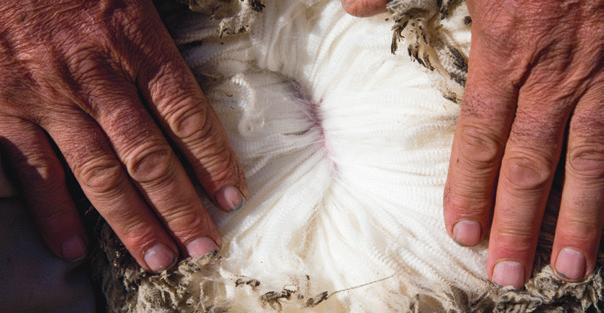
ABOVE: Paul Harmer worked on the station with Kerry before purchasing it in 1992
BELOW: The quality of merino wool is determined by the closeness of its crimp, yield, colour, and staple strength
best of both worlds: fine wool and good finishing lambs,” he says.
All Castle Ridge’s mixed-aged ewes go to the Poll Dorset while the two-tooths and the betterwoolled ewes (about 2000) go back to the Merino for replacements with more bought in when required.
The Harmers have been buying their Poll Dorset rams from George Lowe’s Windermere Stud, near Ashburton, for more than 20 years. They use the Patterson family’s Armidale genetics from Gimmerburn for their Merino rams.
Despite Castle Ridge’s extensive nature, the Harmers put much effort into lambing time. Starting around September 20, most tend to lamb in early October. While the two-tooths lamb a month later on the hill, the rest are split into four mobs and shedded off daily with any obvious spares bought in.
Merinos are not known for their mothering abilities, says Kerry. “Our scanning percentages are usually pretty good, around 140 percent, but our lamb survival is poor because the ewes don’t count very well. We also don’t have a lot of shelter, and it’s quite exposed, so we can lose lambs to hypothermia. I absolutely hated seeing lambs dying. Not only because it’s a loss of profit, but it’s an animal welfare and caring thing.”
Kerry had always reared lambs on a low-cost, bucket-type system, but when it got to the point where she was rearing over 100 orphaned lambs, it became too labour-intensive. They thought there must be a better way. Fourteen years ago, they discovered automatic lamb feeders. While it was
trial and error initially, Kerry has since developed a system that works. They now operate three automatic feeders and rear 700 to 800 lambs that would otherwise not survive as well as actively mothering on.
While the costs increased slightly with the automatic feeders, Kerry says it’s been worth every cent. “Every year we have done it we have made a profit ranging from $20/head when milk powder was more expensive, and the lamb price was low. On average, we make $40-60/head profit, taking into account the extra labour, power, and milk powder.” Though this year may be different with the low lamb price, Kerry says they will continue to save lambs and mother-on.
Most of the ones they’ve hand-reared are on a par with those out in the paddock on their mums, with a good proportion going forward to their on-farm lamb sale in February. They’ve been running a successful on-farm sale since 2005, selling upwards of 8,000 Poll Dorset-Merino cross lambs. One of the biggest sale days on the Canterbury calendar, they have developed a reputation for selling “top-notch” un-drafted prime and store lambs sought after by repeat buyers. Those 1,000-odd leftover lambs are taken through winter and sold after they’re shorn in July for their half-bred wool.
Though the lamb cheque has sometimes made up more than half the farm income, the Harmers remain equally passionate about their wool clip. A longtime supplier to The New Zealand Merino Company, they have been part of Icebreaker’s elite Growers Club on a 10-year contract since 2018. Wool is selected based on fibre length, strength, diameter, consistency, colour, and cleanliness, and that’s where daughter Sam comes in. Having worked at home, for a shearing contractor and spent time working in Australia, she has inherited her parent’s passion for a fibre they all believe in. She recently completed her studies at the Southland Institute of Technology (SIT) and is now a fully-fledged wool classer. Sam was also one of two recipients of the NZ Merino Wool Classer Scholarship, which pairs students up with a mentor


to gain practical experience and training in highquality merino sheds. Sam’s “passion” project is her own 50-strong flock of ultra-fine merinos (below 13 microns).
“Growing up here, I have always been fascinated by the whole process, from the sheep right through to the garment. I understand the whole supply chain, and I think that helps when you’re classing, when you’re taking fleeces out. If you know where a product is going and what it’s going to be used for, you have that in the back of your mind,” says Sam. Shearing takes place annually starting at the end of July and can take anywhere up to a month. Kerry is tasked with the mammoth job of feeding the gang three meals a day, plus smokos. They usually do about 17 or 18 days of shearing during that period, depending on the weather.
With the property prone to cold and snow at any time, Castle Ridge continues to employ the age-old art of blade shearing. “Blade shearing leaves more wool on the sheep and only cuts the staple in half, so it doesn’t comb the grease out. These things are important because the grease is the waterproofing, which enables water to run off and keeps the sheep warmer and drier. This is important due to our climate and altitude,” explains Kerry.
As part of being a grower for Icebreaker, the Harmers are part of the ZQRX programme, a pioneer quality assurance programme committed to strict animal welfare codes and having strategies to protect and enhance the natural environment they work in. But for the Harmer’s, being part of the ZQRX programme is not just about “box-ticking;” it’s central to how they farm and has always been.
“You don’t live in this environment without thinking about it. We live here all the time, and we love it and respect it,” says Kerry. “We are only caretakers, here for such a short time looking after it for those who come after us. We can’t change what’s happened before us, but we can leave it in the best way we can for the next generation. It’s not just a business, it’s a lifestyle,
ABOVE: Shearers and wool handlers spend three weeks on the station shearing 15,000 merinos
BELOW: Blade shearing is a quieter method that leaves more wool on the ewe which is important for the late winter/early spring climate
and it’s everything to us. We have a real tie to this land, not dissimilar to Māori values.”
Kerry, a townie born and bred, has seamlessly taken to life in the high country. Her father, who worked as a journalist for The Press, was a keen botanist and she inherited his love of the environment and trees. “I had always had an interest in farming and animals. I was always going to go to vet school, but then I met Paul and went to Lincoln University instead, becoming a farm consultant. All I ever wanted to do was go farming. Being an agricultural consultant was the next best thing because I was helping farmers.”
Even after she and Paul moved to Castle Ridge, Kerry kept working as a consultant. She’s found her farming knowledge and multitude of skills have been called on more and more in advisory roles in recent years as the pendulum has swung against agriculture and farming.
She’s been a member of Beef + Lamb New Zealand’s Farmer Council and Environment Reference Group and represented the Mid Canterbury and high-country branches of Federated Farmers. Earlier this year, she was reappointed to the Land Information New Zealand (LINZ) High Country Advisory Group. She is also a committee member of the Mid Canterbury Catchment Collective, current chair of the Ashburton Lakes Catchment Group and a trustee of the Mid Canterbury Federated Farmers Charitable Trust.
Over the Harmer’s years farming at Castle Ridge, the rules and regulations placed on their farming practices have grown exponentially and many were contradictory. Being in a “sensitive” lakes red zone, they’ve required consent to farm from Environment Canterbury (ECan) for a number of
years. Their previous consent was for five years, and they’re in the process of trying to renew it but Kerry says the new process is proving more complicated due to the amount of environmental legislation that is up in the air at the moment.
Back in 2019, the Harmers, along with the other farmers in the Ashburton Gorge, joined the Ōtūwharekai Working Group, which includes members from the local iwi, Department of Conservation (DOC), LINZ, Ashburton District Council (ADC), ECan, Central South Island Fish & Game, the Ministry for the Environment, and the Ministry of Primary Industries. They are all looking to collaboratively halt and reverse the degradation of ecology and values in the region.
On the back of that, in early 2023, the farmers officially launched the Ashburton Lakes Catchment Group, which falls under the Mid Canterbury Catchment Collective, to actively monitor impacts on water quality in a planned way and work on ways to lessen their environmental footprint on their own farms.
Though one of the smallest catchment groups nationwide in terms of members, the Ashburton Lakes Catchment Group encompasses some 58,000 hectares over four extensive sheep and beef farms. The catchment group area includes 13 Lakes, the Te Araroa Walkway, numerous recreational hunting, fishing, water, tramping, and snow opportunities, and is enjoyed by many in the extended community.
While they had individually been tirelessly working to relocate winter grazing to reduce the nutrient load near waterways and lakes and have continued to invest in riparian planting, fencing, and stock water systems, Kerry says they needed to know if what they were doing was making a difference.
“At the moment, all the heat is on us as the landowners, but actually, we are only part of this, only part of the problem, and only part of the solution. So, we want to build the science with everybody as part of that and find out exactly what is going on. Up until now, the finger has been pointed at us as the sole cause of it all based on computer modelling, assumptions, and hearsay, and we are already working out that we are not.”

Since last September, farmers have been measuring water quality where the water enters their properties, at a midpoint, and as the water departs. These nitrate tests range from less than 0.002ppm to 1.05ppm, which is extremely low, says Kerry. Some are less than 10 percent of the nitrate levels in the drinking water of the Ashburton town water supply.
She says in 60 percent of areas measured, the water quality does not change or improves as it travels through the properties. In areas where the water quality deteriorates slightly, it relates to the addition of spring water to the streams. Research is currently being undertaken to identify the source of the nitrate (animals, nitrogen fixation, organic matter breakdown or from parent rock material) and the age of this water with hopes that armed with this information; they’ll be able to find ways to reduce nitrate levels coming from the springs.
In June, they received a grant from MPI over the next four years from the Catchment Extension

ABOVE: Castleridge run a 15,000-merino ewe breeding operation alongside 800 Angus beef cows and 250 Red deer hinds
BELOW: Shearing takes place annually starting at the end of July and can take anywhere up to a month
Services Fund, which will allow them to further their research and work to develop practices that will improve their environmental footprint in the basin and then share their findings with others.
Ultimately though, success depended on all landowners, including DOC, working together to balance farming interests with preserving the environment. There has to be some common sense. It wasn’t as simple as fencing all stock off from every waterway and putting in reticulated water sources, says Kerry.
“We’re not talking about metres; we’re talking about kilometres. It would cost over $1 million to do all the fencing that regulations have suggested. We need to have ways to water stock that enables them to use it but with minimal impact. Long term, we are committed, but it’s hard when you aren’t making any money. Nothing happens overnight; this is a long-term challenge.”
With the Harmer’s children - Ben (24), Sam (22) and Annabel (18) - all showing an interest in farming, they’re pushing harder than ever for meaningful solutions that address the whole problem and produce long-lasting solutions. Ben is currently working for the Ensors at Glenaan in the Rakaia Gorge, while Annabel will start vet school at Massey University next year after returning from a gap year in the UK and Sam plans on continuing to work in the industry when she is not wool classing.
“We’re passionate about looking forward and looking after the place. The kids are really keen to continue the legacy and in order for them to do that we need a healthy environment and healthy farming business.”



planning and practice can save you time and money
WORDS AND IMAGERY PROVIDED BY FMG INSURANCE
The last five years have seen $28 million in settled irrigator claims and weeks of valuable production time lost, much of which could have been prevented with a good plan.
FMG’s Advice Product Manager, Abby France, says “winter is the time to be making that plan to minimise the disruption and avoid those expensive repairs. Also, with strains on global supply chains we have experienced in recent years, parts could be hard to source and potentially mean months of disruption.”
There are four main areas of consideration when putting together your plan:
1. Prediction
New Zealand weather patterns are known for being variable and unpredictable. Farmers and Growers are increasingly turning to online tools and mobile apps to help them get ahead of bad weather and put their plans into action. Some of our clients have had great success using platforms such as Metservice and Canterbury Weather Updates as well as apps such as PredictWind and Windy which allow you to set parameters for wind speed alerts.
For example, if the wind speed parameter was set to 90km/hr an alert would be received if the winds were to exceed that speed, allowing you time to plan accordingly. This lead-in time for high winds helps you make better planning decisions from the time the wind is predicted to when the event is over.
There needs to be a clear understanding of who is responsible for monitoring the winds and making the final decision on whether to proceed with the action plan. Lines of authority should include more than one person as the person who normally makes the decision may not be on-farm at the time. As well as understanding who will carry out the plan on-farm, include the person who is responsible for:
• Monitoring the weather
• Making the decision to take action
• Getting the irrigators back in action
It’s important that everyone who works on your farm understands what the agreed plan is if strong winds are on the way. This could include the method of ‘Plan, Point, Park and Anchor’. Everyone should understand their responsibilities and the process. This should

also include what happens after the winds have passed and getting back to irrigating.
It is good to practice your plan, especially if you have new team members who are not familiar with it. These events may be spasmodic, so ‘on the job’ practice is limited. Therefore, time needs to be put aside to practice the plan. This is also a good time to adjust the plan to make sure it runs smoothly when it’s needed for real. Make sure you include health and safety risks in this process so that when the pressure of a real situation presents itself, everyone is safe as they implement your plan.
“Wind damage to irrigators remains the top cause in our claims, accounting for 34% of claims.” says Abby.
“Over half of all wind damage claims occur in spring and there’s real benefit from following the ‘Plan, Point, Park and Anchor’ advice we have developed in conjunction with Irrigation New Zealand.”
Head to fmg.co.nz/advice/irrigators for more information, including access to the free Irrigation Guide to help protect your irrigators this season.

With demand for glamping and back-to-nature escapes growing, Springburn dairy farmers Allan and Heather Broomhall saw the perfect opportunity to diversify their conventional dairy operation and boost farm revenue by adding an off-grid curved cabin next to their irrigation pond.
Nestled in the shadows of Mt Somers and Mt Alford, the Broomhall’s farm Paddy’s Pastures is a 250-hectare dairy farm, milking 680 Friesians. Having grown up on the farm, Heather’s connection to the place is long and deep. Her parents, Carl and Dorothy Shannon, purchased the original part almost 50 years ago, having immigrated from Northern Ireland. The name Paddy’s Pastures is a nod to Heather’s Irish heritage.
In 1967, a young Carl Shannon left Northern Ireland at just 20 years old in search of a new future. New Zealand agriculture promised new opportunities, and with a Kiwi mother, he had the world at his feet. His parents had met in Ireland during the Second World War. After travelling for more than six weeks on a boat, and with extended family in Ashburton, Carl ended up working on a sheep farm in Te Pirita for a year before going mustering in the Canterbury high country. After two years, he sent for Dorothy to join him.
Having worked hard, Carl and Dorothy managed to save enough to buy a small dairy farm at Springburn in 1977. It had been one of the first dairy farms in the county, supplying milk for the town supply. They started with a herd of just 60 cows through a four bail shed before building a 12-aside herringbone. As time passed, the Shannons continued to grow their business, managing to purchase additional neighbouring land, block by block. They also bought a run-off block at Mt Somers and added irrigation through the RDR irrigation

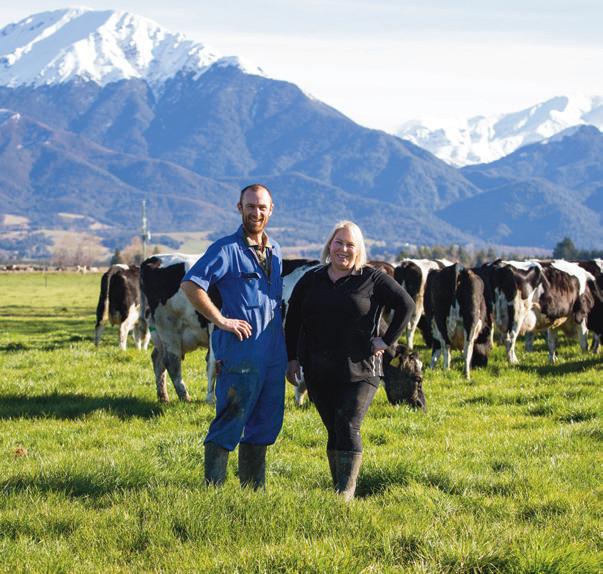
scheme and, later, the Barrhill Chertsey Irrigation (BCI) scheme.
From a young age, Heather dreamt of one day running the farm her parents had worked tirelessly to create. “I had always wanted to. I loved being on the farm. I loved the animals and the outdoors. I went off and studied vet nursing to bring a few skills back to the farm,” explains Heather.
Heather and Allan first met at the freezing works, where Heather was working for Ministry for Agriculture, Fisheries and Animal Rights (MAF). Allan had previously worked as a tractor driver on the lily bulb farm at Rakaia. The couple initially headed to Australia for work but returned when Heather’s father’s farm worker moved on, and help was required.
“Dad had just purchased the block next door and had plans for the new rotary shed. He was going to put a sharemilker on it. He had done it on his own for a long time, but we were keen to give it a go,” says Heather.
Having started at the bottom, they moved to variable contract milking after three years, followed by contract milking. Then, in 2016, Heather and Allan boldly moved to lease the property from Heather’s parents.
“Carl wanted to keep it simple,” says Allan. “We had to buy the cows. It seemed like a big step at the time because we were in control of everything, but in hindsight, it was easier. It made us a lot more aware of the costs.”
Three years ago, they purchased the rest of the farm. Today, they run 680 cows split over
The
BELOW: Paddy’s Pod was opened in January 2024 and has since become a popular escape for out-of-towners
two herds on a low-input system, averaging 430 kilograms of milk solids per cow. The property is located in the rain shadow of Mt Somers. It has its own unique weather, with an average annual rainfall of 1,000ml. Additional water from irrigation (about 70 per cent of the property) through pivots, K-Line, and a gun was critical to increasing cow numbers.
While Allan swears they live in paradise, fine sunny days are often traded for snow, cold and wind. “I’ll happily put up with the cold for this view. It is the best office you can get,” he laughs. However, due to the colder temperatures and slow grass growth, the Broomhalls farm accordingly. It’s about farming to the conditions. “We have learnt much about farming here from Dad,” says Heather. They calve later (August 10), yet they still dry off at the end of May. During the season they drop from twice a day milking to variable milking (3 and 2) in February. “We keep them drier for a little bit longer. It’s down to profitability rather than chasing milk solids. It’s also better for the animals. We tried to push to 700 cows, but we weren’t making any more profit,” explains Allan.
Carl has had Friesians since the very beginning, operating a closed herd. He spent years
breeding them to be hardier and better-suited to the unique conditions. But since buying the herd eight years ago, the Broomhalls have invested in cleaning up some of the traits they weren’t happy with by putting World Wide Sires (WWS) genetics across their Day 3 cows (which traditionally had the lowest breeding worth).
“We were becoming concerned at the quality of the udders we were seeing in our cows, the feet issues, and also the number of cows we had to calve,” says Allan.
Heather says they could see the difference from the moment the first calves hit the ground. Despite having lower birthweights, the calves quickly outgrew their Kiwi counterparts and were good, strong calves. When they entered the herd, those calves fulfilled their potential as heifers, showing good milking abilities. A handful were among their top producers that season. Initially, Allan and Heather started off buying just 100 straws, but since purchasing the farm, they have moved to 100 percent WWS and were really starting to reap the benefits.
Last March they introduced CowManager, which has meant a move to 100 percent AI, eliminating the need to buy in bulls. One of the big drivers was the danger factor, explains Allan. “We had had so many close calls with me and bulls and staff and bulls.”
Heather raises all their replacements, while they have a buyer for all their bull calves at four days old. They also put Angus across the tailenders, with the resulting beef calves also sold at four days.
A big part of Paddy’s Pasture’s success is its staff. They have three full-time staff members, with the juniors changing each year. Following on from where Carl left off, the Broomhalls have continued that Irish connection, relying on Irish students to fill their junior roles alongside their Kiwi 2IC/assistant
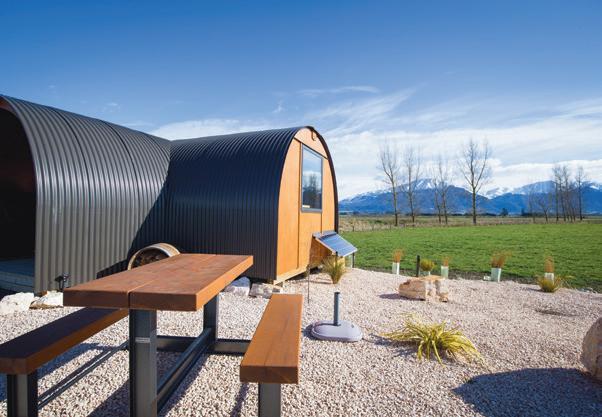
manager. They have wonderful, long-standing relationships with Green Mount College and Queens University in Northern Ireland. Students typically come for 12 months, enjoying all New Zealand offers in terms of different farming practices. Many haven’t seen dairying on this scale before.
“It works well for us,” says Heather. “They usually are all off farms and hit the ground running.”
“They all want to learn to farm,” adds Allan. In addition to their dairying operation, earlier this year the Broomhalls took a nervous punt and opened Paddy’s Pod, a “glamping”— glamorous camping—experience which they operate through the Canopy Camping umbrella.
They needn’t have worried, though. Agritourism has been booming in the wake of COVID-19 as urban dwellers seek to

ABOVE: Methven’s Mount Hutt Pods built the cabin locally, with Heather and Allan undertaking the landscaping for the site
BELOW: The pod is fully self-sustainable, including a wood-fired hot tub and composting toilet
reconnect with nature and the outdoors. From the moment they opened their doors, the demand for bookings has been swift and strong, with guests keen to explore the Broomhall’s piece of paradise.
They had long thought their 6-hectare irrigation pond was worthy of sharing with others, but it was only after their three boys— Kaidyn, Blake, and Dane—started growing up that Heather started searching for something that she could sink her teeth into and generate some extra revenue off-farm. She looked at getting a part-time job in Ashburton, but it failed to give her the flexibility to fit around the boys or rear calves. They had a few different options, but after doing a budget, glamping came out on top.
“We’ve spent many of our summers down at the pond, and we’d always thought it would be great to share it with people. We live in a magical part of the world, surrounded by breathtaking views. The wildlife on the pond is amazing; every day we go down there you don’t know what you are going to get. There’s nearly always swans but we also have some resident rare Australasian Crested Grebes. And with the reopening of the Sharplin Falls track and the Staveley Ice Rink, there was a lot of tourism coming our way, and we wanted to capitalise on that,” says Heather.
Early on in the process, Heather contacted Canopy Camping, a company that runs a website, marketing service, and booking platform, for glamping campsites around the country in exchange for a commission. Canopy Camping was started by two uni-friends in 2012, looking for somewhere to escape
with their families, something unique and outdoorsy. It has since grown to include almost 200 sites across the country.
“I just really liked their niche. I approached them with what we had and our ideas, and asked what we would need to do, and they were all for it,” says Heather.
Working closely with Canopy Camping, the Broomhalls installed a beautifully crafted, small-footprint, fully self-contained, totally off-grid wooden cabin. The cabin is complete with a cosy bed, compact kitchenette, bathroom, small fire and barbecue for cooking, and a deluxe wood-fired hot tub.
Mount Hutt Pods in Methven built the cabin locally. The whole project took about six months from conception to fruition, with Heather ensuring no detail had been overlooked. They even have e-bikes available for hire to bike around the pond or to The Staveley Store & Cafe.
“Being part of Canopy Camping made it a lot easier. They gave us templates and timelines to follow. Just having their followers, we would never have been able to grow that. It went live on the website on January 1, and we had our first booking within two hours of opening. It was crazy. It was much busier than we even expected. We got so busy in those first few months that we had to upgrade the califont (gas water heating) and solar panels.”

And it hasn’t really stopped, with occupancy sitting at around 80 percent, says Heather.
“We really didn’t know who our clientele would be, but we’ve had all sorts, from tourists to

ABOVE: Allan with Katie Flynn (from Ireland), and manager Kate Kilpatrick (right)
BELOW: Agritourism has been booming in recent years as urban dwellers seek to reconnect with nature and the outdoors
honeymooners, travellers, and retirees. A lot come from Christchurch. It feels like you are miles away when you are there, but you are actually really close to amenities with Methven and Stronechrubie nearby. It seems to appeal to people.”
Guests are welcome to come and watch milkings, but to date few have taken them up on it. Most are simply content with enjoying the cows from a distance, while soaking in the privacy, peace, and quiet.
The Broomhalls have found that most guests simply want to be left alone, with interaction minimal other than through email.
Though the pod was keeping the Broomhalls much busier than they’d anticipated with the constant turnovers and cleaning, it’s a good busy, especially with the continuous dairy payout changes, increases in farm costs, and the cost-of-living crisis. Although there had been a few teething problems, by and large, they were enjoying the experience of welcoming guests on to their farm. The biggest issue was remembering to book it out to give themselves a break. Heather admits there had been a few times when they’d been caught out. She’s recently employed a calfrearer who can also help out with the pod when needed.
“We are so pleased that we’ve done it. I can work it around our life and the roster,” says Heather.

JOIN RURALCO AND ENJOY CONVENIENCE, COMPETITIVE PRICING, AND EXPERT ADVICE FOR YOUR FARMING BUSINESS. RURALCO WAS FOUNDED IN 1963 BY LOCAL FARMERS WHO WANTED TO SUPPORT FARMING OPERATIONS IN THE DISTRICT AND WE HAVE THAT SAME VISION TODAY.
As a shareholder we support your farming business by offering:
• Competitive pricing on farm supplies, seed, energy, bulk fuel, and fertiliser.
• Access to discounts at over 3,000 businesses and fuel outlets nationwide with your Ruralco Credit Card.
• Ability to purchase product in store or online with delivery* to your farm
• Convenience of one monthly statement for consolidated spend and improved cashflow
• Individual account management with personalised farming advice and on farm support available.
• Annual rebates relative to your spend, subject to rebate declaration by the Board of Directors.
• Exclusive events and promotions.
Find out more and apply to be a shareholder online* at ruralco.co.nz
* Eligibility criteria, lending criteria, terms and conditions apply.

Providing standout electrical services across the residential, commercial, rural, and dairy sectors continues to be the main driver for Level Electrical Ashburton, just as it was when Mid Canterbury local Les Christie first established the business in 1980.
Then known as Christie Electrical Ltd, Les’s son, Brent, completed his electrical apprenticeship under his father’s expert tutelage and guidance. After a short stint overseas, he returned to work alongside his father, and upon his retirement, Brent and his wife and business partner, Megan, took over in 2009. Their three daughters have all grown up working in the business and were well known for voicing the radio adverts. Now, Milly, who is part-way through a commerce degree at Canterbury University, has recently started helping with marketing.
Since its humble beginnings, growth has ensued, with new branches opened in Rolleston, Geraldine, Temuka, and Timaru. Now, with a team of almost 50 employees spread across the wider Canterbury region, the business specialises in a wide range of electrical services, including commercial, rural, residential, and industrial electrical, air conditioning, PLC programming, solar and data communications, as well as an extensive top-tier offering of home heating and lighting solutions. Its scale means it can share staff for more significant projects as required. It also offers a 24-hour on-call service.
Boasting unparalleled knowledge and expertise across all facets of the business, many of the
team members have been with the Christie’s since the business’s early days.
“The rural side has always been a big part of the business, and it continues to be. The rural sector has many aspects, from supplying new installations to repairs and maintenance. In addition to dairy sheds, we do irrigation systems, pumps and motors, robotics, automated control systems, potato sheds, grain drying floors, and maintenance within farmhouses,” says Megan.
Heading the Rural and Dairy team is Phil Moore, who started working for Les Christie after school and has been with them for 29 years. There are few dairy sheds in the district he isn’t familiar with. He is joined by Senior Service Electrician Rob Ridden, who has been with the company for 19 years; Dairy Technician and advanced fitter/ welder Craig Hydes, a qualified electrical engineer who has been with the company for 14 years; and electricians Ruzz MacLean and Blair Milligan who have been with them for five and two-and-a-half years, respectively. They also have Jack Bull, who is eight months into his apprenticeship.
Rob has witnessed many changes in the dairy industry since he started, from the old pulsator systems that required antifreeze so they didn’t freeze during winter to the replacement of manual cups on and off to automatic cupremoving systems. Teat spraying has also moved from a handheld spray gun to robotic technology.

Rob loves working with farmers. “As a Service Technician, I love the challenge of finding the problem and fixing it as quickly as possible. Isolating the fault can often be challenging, as the initial issue could be tripping in the switchboard, but the cause could be rodent-chewed wires or mechanical damage some distance away from the switchboard, even across the yard.”
He says the whole Rural and Dairy team enjoy the wide open spaces on farms and the variety of work.
Despite undergoing numerous changes over its existence, at its heart, it has remained a familyowned business committed to servicing rural Canterbury. So, when Australian-based Level Group, founded by ex-pat Kiwi Luke McCallum, sought to expand its trade network into the New Zealand market last year, the Christie’s jumped at the opportunity to become the first South Island electrical contractors to join the Level tribe.
Level Group symbolises passion for the craft, professionalism, and pride in the work. It’s about standing out in the industry. For the Christies, those values, along with being family-owned and operated, “aligned more with who we are and what we’re about,” explains Megan.
“The decision to join Level was a no-brainer for us and our team, as we want to be a part of something bigger and a group powering ahead. The opportunity was timely, and we are really looking forward to the journey and growing with the brand,” says Brent.
ABOVE: Phil Moore, Craig Hydes, Blair Milligan, Jack Bull, Ruairidh (Ruzz) MacLean
BELOW: Brent and Megan Christie

ashburton@levelelectrical.nz www.levelnz.nz/electrician-ashburton/


Farm confidence has fallen since the start of the year, with debt, interest rates, and banks causing the greatest concern to Kiwi farmers. WORDS & IMAGES PROVIDED BY FEDERATED FARMERS.
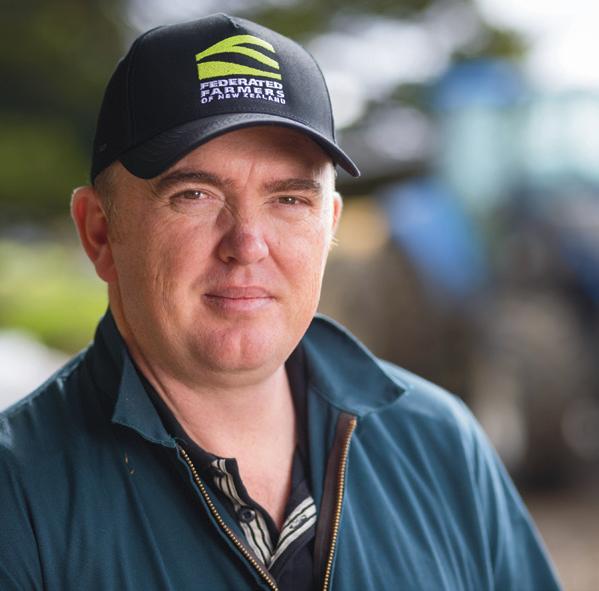
Federated Farmers’ latest Farm Confidence survey of 1400 dairy, sheep, beef and arable farmers shows confidence remains stuck in historically low territory.
“It’s incredibly frustrating to see farmer confidence is still sitting at these stubbornly low levels,” Federated Farmers national president Wayne Langford says.
“Unfortunately, these survey results are just reflecting how farming families are truly feeling out there at the moment.”
“Farmers have really been doing it tough for some time now, with high interest rates, low commodity prices, and sky-high input costs making it really hard to earn a living.”
Langford says Federated Farmers were encouraged by a slight lift in farmer confidence in our January 2024 survey—but things have since gone backwards.
“Restoring farmer confidence is a huge focus for Federated Farmers. It’s what gets me out of bed each morning, feeling motivated to make a difference”.
“We clearly have a big job ahead of us, but we’re up for the challenge. We’ll keep pushing hard to improve the lives of farming families across the country.”
“The Government have done a lot of work repealing and rewriting some of the most unworkable regulations, but there’s still so much more to be done.”
The six-monthly survey clearly shows it’s not only regulation eroding farmer confidence, Langford says.
“There are a whole range of other issues also having an impact, like concerns about banking, high interest rates, soft farm-gate prices, the ability to find staff, and the general economic outlook for the country.”
Done in mid-July, the survey found more farmers consider the current economic climate to be ‘bad’ compared to January.
This is the second-worst result in the survey’s history, with the lowest being July 2023.
Things are no better when looking ahead, with more than half of farmers expecting economic
IMAGE: Federated Farmers national president Wayne Langford
conditions to deteriorate in the year ahead, slightly worse than in January.
“The survey also paints a bleak picture of what’s happening with farm profitability,”
Langford says.
“Just over a third of farmers are making a loss right now, while only 27% say they’re making a profit and 39% breaking even.
“If that’s not bad enough, more than half of farmers expect their profitability to decline over the next 12 months.”
Langford says he’s deeply concerned for farmers’ wellbeing and what this might mean for their families, rural communities, and the wider New Zealand economy.
“About half of farmers told us their mental health and wellbeing is being affected by worries about things like interest, farmgate prices and regulation. “
“We want to see farmers thriving and feeling confident, not lying in bed stressing about how to pay their bills and keep the lights on.
“When farmers lose confidence, they cut their spending and shave costs from their business, and that has major flow-on effects for the wider economy.”
Farmers surveyed said their biggest concern right now is debt, interest and banks.
“This is consistently coming through as the main issue for farmers, which is why we have pushed so hard for an independent inquiry into rural banking.
“It’s great the Government have given an inquiry the green light, but farmers actually want to see action and for changes to be made to the system.”
The survey also shows farmers are having serious challenges recruiting staff. “Finding skilled staff is a major issue, particularly for dairy farmers who are in the thick of calving right now.
“It’s concerning that farmers are finding it much harder to recruit skilled and motivated staff over the past six months than the previous six months.
“It’s nearing crisis point this season, with recent changes to the Accredited Employer Work Visa scheme causing all kinds of issues.”
Langford says Federated Farmers will continue to work with the Government to urgently address these issues and restore farmer confidence.
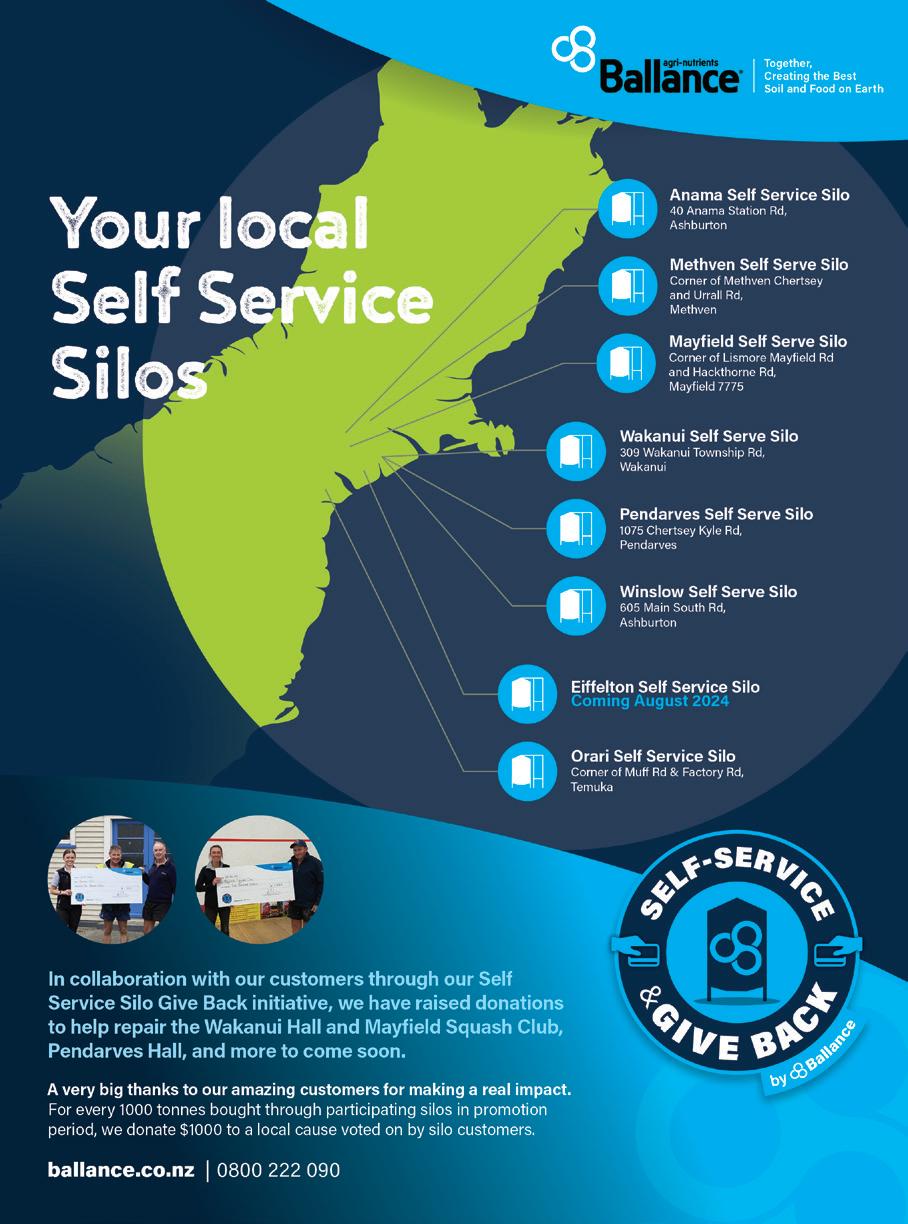
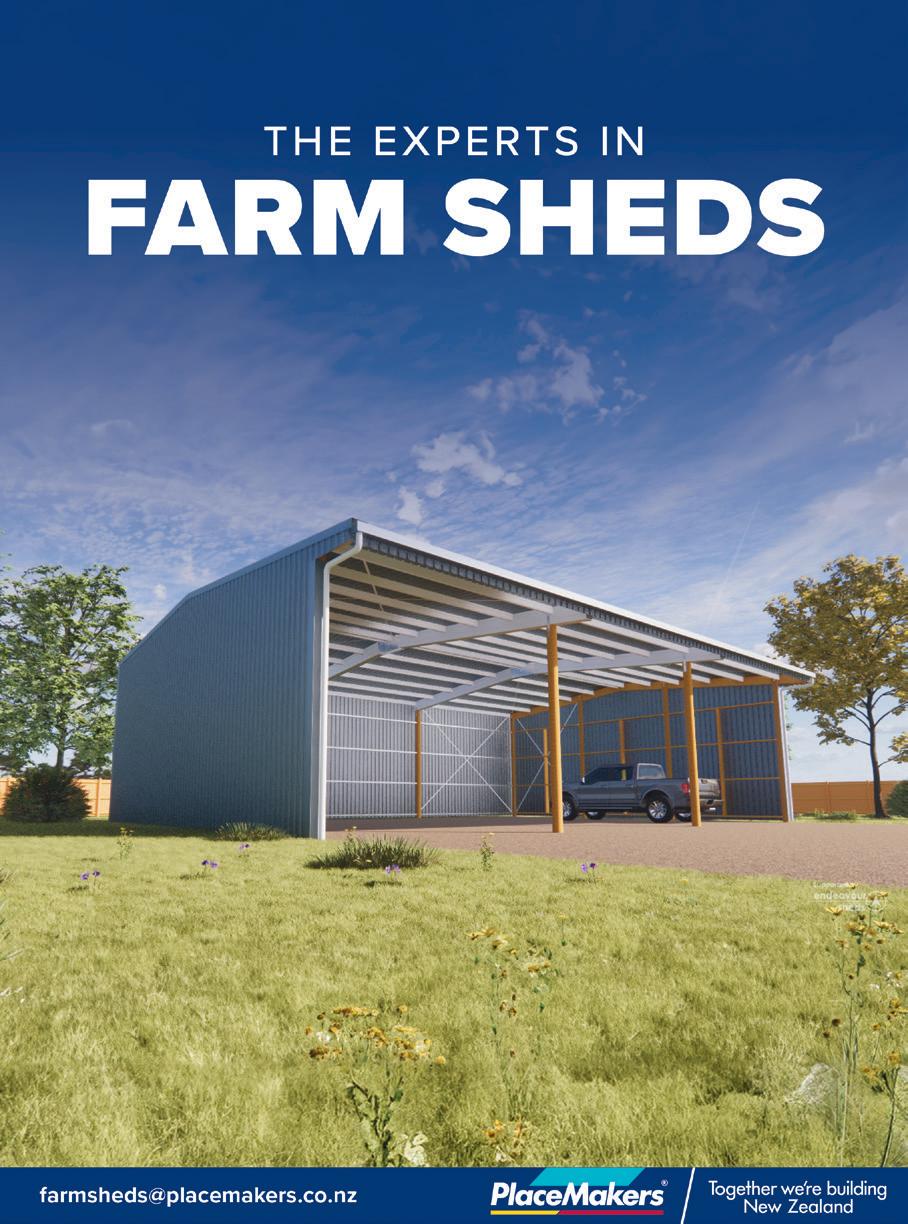


Almost since the first settlers commenced pastoral farming in New Zealand, the science of farming and agriculture has grown around and alongside them. WORDS & IMAGES BY RICHARD RENNIE
Canterbury, as one of the first regions to be established and grow firmly on the sheep’s back, also welcomed the foundation of the School of Agriculture of Canterbury University College, back in 1880. This makes today’s Lincoln University the oldest agricultural teaching institute in the Southern Hemisphere.
Those first 56 students were the pioneers who built the reputation that followed for innovative, dynamic, and effective research that has helped turn the country into a successful growing nation, despite being thousands of miles from many of its customers.
They were innovations that kicked off with frozen meat shipments and span electric fences, rotary cowsheds, ryegrass hybrids and dual-purpose sheep. All have equipped the sector to leverage off New Zealand’s natural advantages of a maritime climate and multiple fertile soil types. But today concern is rising within New Zealand’s agricultural and horticultural sector that this culture of innovative research and groundbreaking technology may be losing its momentum.
Constant funding declines and uncertainty over Aotearoa’s future science direction is leaving
scientists looking sideways at overseas options, or simply opting out and taking early retirement, along with their knowledge and wisdom.
This was brought into stark reality in the depths of this winter, with June 30 marking the official end of the funding period for the country’s 11 National Science Challenge funding pools.
Covering a wide variety of research areas such as better aging, high value nutrition and Our Land and Water, the challenges represented about $60 million a year of funding that came to an end, and with it the work streams and expertise these challenges had built up.
Funding from here on in remains uncertain while an enquiry into the future of New Zealand’s science funding continues under the leadership of Sir Peter Gluckman.
Meantime scientists in units directly related to improving agricultural value and output, including the high value nutrition challenge, have opted to continue on despite no certainty of funding between now and whatever recommendations Sir Peter’s group make on future funding.
High value nutrition director Joanne Todd said there was a real risk her unit would lose talented staff, and the decision by them to stay in the meantime highlighted their commitment to their research.
The unit, which received $80 million over its 10 years of funding, has been responsible for high-profile value-added success stories over its lifetime. That includes identifying the sleep-promoting properties of Zespri kiwifruit and proving the high nutrient profile of Torere Macadamia nuts from Gisborne.
She has called for interim funding for her and other challenge units to at least enable them to continue operations until new funding directions come from Sir Peter’s review.
This review has also been met with some caution by the Parliamentary Commissioner for the Environment, Simon Upton.
In his submission to the science advisory group, he acknowledged the need for change in funding processes, but he also cautioned against “reinventing the wheel” and focusing too much on bureaucratic reform as the review’s starting point.
Death by 1,000 cuts
Lincoln University professor of agricultural science Jon Hickford is concerned the review may only end up making changes around the edges, and risk not grasping the full implications of cuts already suffered by the sector over the years. It also comes after a Budget that failed to deliver on any level for science, in fact slicing off $500
million from capital costs in science, innovation and tech portfolios over the coming five years. This included a loss of $4.5 million a year from MPI’s sustainable land management and climate change research, just as the impact of climate change on farming is intensifying.
It came after earlier public sector cuts in April. But then Professor Hickford highlighted cuts the agri-science sector had already suffered, whilst many parts of the public sector had been busy growing their staff numbers.
AgResearch’s full time staff dropped from 722 to 666 between 2019 and 2023, while the axe also fell across NIWA science staff, and the Callaghan Innovation centre looked at a strategic reset with prospects 30 staff members could also go from there.
“The real concern with the latest science challenge funding ceasing, is where this leaves New Zealand internationally when it comes to its level of research and development funding,” he says.
New Zealand’s position on this is already perilously low on the OECD ladder, with 1.47% of GDP spent on R and D in 2022. That compares to 1.67% for Australia, and well below the OECD average of 2.73%. South Korea and Israel top the expenditure list at about 5% of GDP each. South Korea’s investment has been rising steadily throughout the 2000s, sitting over double what it was 20 years ago.
He pointed to the loss of the $90 million National Challenge funding pulling New Zealand down further, to about 1.37% of GDP.
Professor Hickford highlights a Treasury report done back in 2002 that valued the return on investment into agriculture over the years from 1927 to 2001 when the sector enjoyed a 1.8% increase per year in productivity. Estimates were the return on investment in domestic R and D was a massive 17% a year.
“Farmers and growers have proven they are good at adopting new processes to maintain productivity over the years, in a sector that has persistently outdone the rest of the economy.
“But my concern is a decline in research means growth will plateau. It comes at a time too when we are seeing a generation of skilled researchers retiring and a skills vacuum is emerging.”
He says universities are struggling to recruit domestic PhD students equipped with a stock standard B Ag Science degree. Given New Zealand’s pastoral farming systems are something shared with few other countries he says it can take years for overseas students to come to grips with the unique research challenges these systems present.
In July the NZ Herald underscored the cuts to date, with an article on a report that catalogued the losses as amounting to over 350 jobs across the small science sector.
Conducted by the Save Science Coalition the report also maintained that loss could go higher still. It has added to calls for government to recommit to its undertaking to lift R&D investment to 2% of GDP, and urgently introduce funding to fill the gap left between now and a new funding pathway’s establishment.
New Zealand’s scientific community is nervously awaiting some short and medium-term direction from the government.
Dr Troy Baisden, co-president of the NZ Association of Scientists says he is not hopeful about replacement funding coming for the likes of Our Land and Water Challenge, one closely related to agricultural research outcomes.
“The pressure is on Sir Peter Gluckman leading two advisory groups which must make a case for the reforms to help us rebuild the mojo

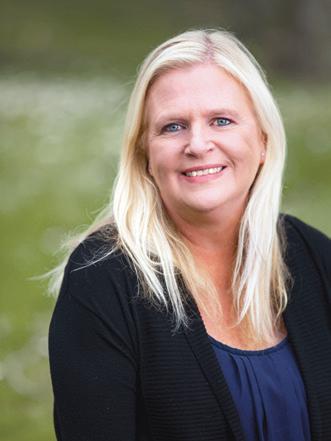
ABOVE: Joanne Todd, director
are committed to staying and continuing their research, despite uncertainty over how they will be paid in coming months
BELOW: Professor Troy Baisden, co-president of NZ Association of Scientists is not overly optimistic about the outcome of a science review now underway for addressing a lack of science investment
BELOW LEFT: New Zealand is running well behind R&D investment giants like South Korea, ranked as one of the biggest investors globally, putting about 5% of its GDP a year into R&D
that drives investment and success across the science system and universities.
“The groups will need to provide vision and hope for science and tech to address our biggest challenges with effective strategies in areas such as primary industries and coping with climate change and hazards.
“Peer nations are investing more and more, and we should as well.”

There were plenty of reasons to celebrate Ruralco’s Instore Days this year. It was the 30th anniversary of this revered mini field-days event and this year there were special guests, with the Prime Minister, Christopher Luxon, local Rangitata MP, James Meager, and Federated Farmers national president, Wayne Langford, in attendance.

With over two thousand people attending the two-day event, there were many opportunities for Mr Luxon and James Meager to hear firsthand from a wide variety of farmers, and from the businesses which supporting our farming community.
Ruralco CEO, Tony Aitken, says this year’s 30th anniversary Instore Days provided the perfect platform. “Ruralco is here for the local community. Our focus is to make farming easier, and we are proud to be a conduit to facilitate opportunities such as the Prime Minister’s visit where our farmers, merchants and local businesses have the chance to speak directly to their Prime Minister.”
“We work hard to create touchpoints with our farmers, and our Instore Days is a particularly important part of that process. To have the Prime Minister in attendance was a wonderful addition to what was already a significant milestone for our Mid Canterbury based co-operative as we celebrated our 30th Instore Days anniversary.”
Local farmers and business people who spoke with the Prime Minister were impressed with his genuine interest and understanding of the issues facing the primary sector, his knowledge of the region and his personal connections to the area—one of his grandfathers worked at Coldstream Estate, while the other was the principal of Willowby School; his father attended Lowcliffe Primary School; and his wife’s first teaching position was at Tinwald Primary School. Tony says the visit was a wonderful opportunity to highlight how important Ruralco is to the Mid Canterbury region, and this was evident by the number of people who turned out to connect with the Prime Minister. “Lunchtime is always a busy time at Instore Days, but the day the Prime Minister attended, it was particularly noticeable that people were also here to connect with him.”
While the Prime Minister’s visit was a highlight, Tony says there were many other successes achieved through this year’s Instore Days.
A new initiative this year was the Ruralco Hub featuring advisory and advocacy support from industry organisations and representatives such as the Mid Canterbury Rural Support Trust, Federated Farmers and Primary ITO. Farmers had the opportunity to catch up with several industry personal, including Federated Farmers national president Wayne Langford.
Another measure of success is attendance numbers and the level of positive interactions between farmers and retail and merchant attendees. “Despite the cautiousness currently being shown in the rural sector, there were great numbers through the doors, and plenty of genuine interest in the many products and services on show.”
It is always a popular event for local farmers to come to town and to meet and mingle with each other, local businesses, and Ruralco staff to hear first-hand about new technologies, innovations and to access some great deals.
Tony says it was great to see farmers conducting business in their local Rakaia and Methven stores before heading to Ashburton to catch up with other farming folk over lunch. “It demonstrates the value of our Instore Days is not only in bringing you great deals and specials, but also in providing an occasion to come together.”
“We have many local businesses and merchants who have been very loyal supporters of our Instore Days, with some dating back to our original Instore Days. We always welcome these opportunities to work together to support our farming community, and we want to continue strengthening those ties.”
It’s especially significant for Ruralco as it continues implementing its local strategy which sees the co-operative return to a strong local farmer focus, with an emphasis on being based in Mid Canterbury, serving the Canterbury region.
“We are very fortunate to have such a loyal and parochial support base. Our size and local focus gives us opportunities that many others do not have—that is to be very connected and responsive to our farmers. Instore Days is one of the ways we do this well.”
As part of this year’s 30th anniversary celebrations a number of prizes were on offer including a chance to go into a draw to win up to $15,000 worth of House of Travel vouchers, while in-store shoppers also had the opportunity to win one of 30 prizes worth $500 each. This year’s major prize winners were Copland Fields, Deegan Dairies and Love Agricultural Contracting.
Every year the Best Site competition at Instore Days is hotly contested, with around 80 site-holders vying for either the best Retail or Partner site award. The Best Site Retail award is for businesses who transacted through the farm supplies retail store, while the Best Site Partner is for Ruralco merchants stationed in the Ruralco marquee.
Judges this year were Ruralco Director, Kate Beaumont-Smith, and Robin Smith formerly of Lynn River for the Retail award, and former Ruralco Director and Chair, Phil McKendry, and Ruralco Director, David Barron, for the Partner award.
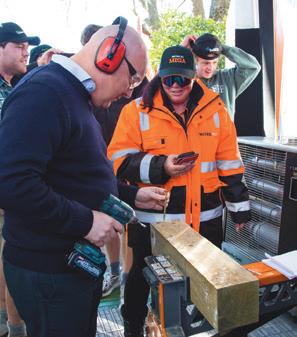

The judges congratulated site holders for the high calibre of displays and knowledge shared through the judging process.
In announcing the winner of the Best Site Partner award, judges said there were some close contenders for the runner’s up award, which was taken out by long-standing Ruralco merchant, Newlands Auto Electrical, but the coveted overall winner was won by another long-standing Ruralco merchant, Stocker Solutions. The judges praised the diversity of services and products on show, and especially the new technology on display which had only arrived in the country the day before Instore Days took place.
That new technology took the form of an automatic calf feeder master-unit which was made in Ireland and arrived just in time for Instore days. Stocker Solutions owner/operators, Shane and Cheryl Stocker say the milk powder feeder generated plenty of interest, and having the importer on-site to answer questions was also beneficial. The feeder had been created following extensive market analysis of other brands and technology, and because of the similarities between New Zealand and Ireland’s spring calving operations, looked to be a good fit for local dairy farmers.
Stocker Solutions is based in Ashburton with dedicated milking, plumbing, effluent, pumping and industrial teams. They say it was great to have something so new to the market to share with Instore Days attendees, and winning the Best Site Partner award was a fantastic bonus.
Best Site Retail judges Kate Beaumont-Smith and Robin Smith also found the judging process fun and challenging, saying the competition tough, but described the winners as very worthy. Ashburton based RX Plastics was named runnerup, while nationwide distributor, Agritrade took out the top prize.
Agritrade Sales and Marketing Executive, Alana Dickey says it was “pretty remarkable” to win. “It’s our first time winning and is a testament to the team’s knowledge and passion for their jobs. We’ve been coming for seven or eight years now, and we will definitely be back to try and reclaim it again next year.”
OPPOSITE: Prime Minister Christopher Luxon
Ruralco Shareholders and Mid Canterbury Farmers Raul Evandro Benavente Pena and Vaneza Alejandra Escobar Morales
Alana says they tried hard to cater for everyone but having games and competitions for all ages. She says their site had great foot-traffic, which meant the team were able to connect with many attendees to discuss their key products including Active+ drenches, Horizon injectable minerals and the Valagor range to name a few. Agritrade’s range of products area all aimed at helping New Zealand farmers to grow better every day.
Many of the attendees at this year’s Ruralco Instore Days have a long association with the event, with a few retailers, suppliers and farmers having attended every Instore Day event. One such person is Mid Cantabrian and Strainrite Fencing Systems specialist, Struan Moore, who also this year attended his 35th National Field Days.
“I’ve been a shareholder since the early 1980s and started attending Instore Days in that capacity, and then later as a retail supplier. I have many great memories of these events including when there was a line of desks inside the showroom, with staff busily taking orders on phones, just like a Telethon. More recently a lucky draw of car, boat and motorcycle was a new level of event marketing.”
Struan says the atmosphere at Instore Days has always been fantastic. “There’s always been a strong community spirit here, with friends, family and old farming neighbours catching up over the two days. The event has been great for business too and it’s very gratifying to be a supplier of fencing solutions to multiple generations of shareholders. Mid Canterbury loyalty is strong, and the Instore Days formula is one that works. It is the envy of other retailers around New Zealand.”

Congratulations to the winners of this year’s Instore Days
major prizes—three House of Travel vouchers worth $5,000, $10,000 and $15,000. Every $250 spent during the month of June and up until 7 July gave members an opportunity to accumulate entries to go in the draw.
$15,000 House of Travel Voucher
Copland Fields
$10,000 House of Travel Voucher
Deegan Dairies
$5,000 House of Travel Voucher
Love Agricultural Contracting

Kids
Pre
5–7 Years
Charlotte
Ava





ALLIED
Allied Gift Pack
Rakaia Dairy Ltd T/A Mead
AGRICOM
50kg of Manta LE
Superstrike Treated
Back Track Dairies
AGRITRADE
Coffee Machine
Milk IQ
AGRIVANTAGE
Calf Rearing Kit Voucher
Paton Trading Co Limited
AHD
$500 worth of AHD products
Dennise Hood
BA PUMPS & SPRAYERS
Matabi Electric Sprayer Pack
B G McGuigan
BALLANCE
1T of SurePhos
Jen & Milzeys Petfood Ltd
BARENBRUG
Barenbrug Gift Pack
L J & A A Sandrey
BELL-BOOTH



2 x 20L Nutrimol 4n1
McFarlane Fields Ltd
BETACRAFT
Wet Weather Gear
Scotsburn Farm Limited
BLUE PACIFIC MINERALS
$500 worth of AgriFert Products
D T D & J C Clark
$500 worth of Animal Health Products
G H & F W Cameron
BLUNDSTONE/JOHN BULL



1 pair of John Bull boots and dartboard
Inverfarming Ltd
1 pair of John Bull boots and dartboard
Flavio Naf
CARRS SUPPLEMENTS NZ
LTD/CRYSTALYX
$500 worth of Crystalyx products
GT & PC Holdings Ltd
CASTROL
WX10 Portable Pump
Mt Alford Station 2015 Ltd
CROPMARK SEEDS

$500 worth of Kea Kale
Ranui Partnership Ltd
DATAMARS
S500 Solar energizer
Redcliffs Station Ltd
ELECTRASERVE
$500 Voucher
Brackleigh Farm Limited
ENSOL




x3 Oilskin Vests & $100
Ruralco Voucher
Bonar Farms Limited
EUROAGRI IMPORTS
$500 Voucher
Wairuna Farm Limited
FARMGUARD
100ltr drum of Maximize
Mundtville Farms Ltd
FMG
$500 Ruralco voucher
Brettwhanau Farming Limited
$500 Ruralco voucher
Rivermount Farms Ltd
$500 Ruralco voucher
Mt Alford Station 2015 Ltd
GALLAGHER







Integrated Solar Energizer
Aberdeen Farm Limited
GLUYAS MOTOR GROUP
$500 Gluyas voucher
BROOKSIDE AGRICULTURE
LIMITED
HYNDS PIPE SYSTEMS
Hynds Pipes Gift Pack
Kilmurry Farm 1 Limited
LYNN RIVER
$500 worth of Lynn River products
C E Galway
MERIDIAN ENERGY
$500 Meridan Credit & Prize Pack
The Alan Wright Trust
MILKBAR
x100 Milk Bar Teats
NANAK DAIRIES LIMITED
MILLIGANS FEEDS
$500 worth of Milligan Products
AVERILL FARMING LIMITED
MITRE 10 ASHBURTON
$500 voucher
Methven Farm Services
NESTLE PURINA
3 x bags of Proplan Performance
Andrew Wright
NEUMANNS TYRES
$500 voucher
D L Hart



NEWLANDS
GME XRS-660 Hand held radio
D W & M D Maw Limited
NORSEWEAR NZ LTD Gift Pack
D L Hart
NUFARM
AR Croppak 60l 12v Sprayer
P J & S M Lambie
NUTRITECH (TERRAGEN)
$500 voucher
Sabas Dairy Ltd


ON FARM DATA BBQ R J & S J Dyer
ORION AGRISCIENCE
$500 Hunting and Fishing Voucher
HJH Contracting
PGGW SEEDS
$500 worth of PGG Wrightson Seeds FLIRT WITH LIFE LIMITED
PIONEER

Bag of treated maize seed M & A Vlaanderen
RAGT
RAGT Pasture Pack x2
M F & D M Slee
RESENE PAINTS








Resene $500 voucher
High Country Journeys
RUMINATE
7 Bags of Gutsiweaner 25kg
B & C McIntosh Ltd
RXP
$500 RXP voucher Braam Landscapes
SPARROWS
$500 voucher for RM Williams
Padlea Dairies Limited
STALLION
Stallion Pen Pack
P A Lowe
STOCKER SOLUTIONS
$500 voucher
Tullymett Farm Limited
SUMMIT STEEL & WIRE
Wire Gift Pack
B J & J B Sauer
SWANNDRI
$500 of Swandri Gear
L & N Jones Farms Ltd



In New Zealand’s dynamic farming landscape, staying ahead means embracing innovative solutions, especially when it comes to perennial ryegrass. After many years of development, RAGT proudly introduces their own novel endophyte, RGT18.
RGT18 sets the bar high by offering superior tolerance against a wide array of insects, surpassing the renowned AR1. It ensures peak animal performance, while minimising the risk of staggers.
Rigorous testing, including extensive agronomic trials and assessments for insect
protection and animal safety, underscores the exceptional performance of RGT18.
Independent animal safety trials conducted over a comprehensive 5-year period across diverse ryegrass genetic backgrounds confirm that RGT18 is a very safe endophyte for sheep, beef and dairy.
The benefits of RGT18 are impressive. With its strong tolerance to key pests like Black Beetle and Argentine Stem Weevil, RGT18 offers New Zealand farmers a comprehensive solution to mitigate insect pressures and increase persistency. Ongoing trials for pests like Porina promise even broader protection. RGT18 is now available with RAGT Hustle, a variety that stands out as one of
New Zealand’s top-performing perennial ryegrasses. Now fortified with RGT18, Hustle emerges as a powerhouse, offering incredible pest protection precisely where it’s needed most.
PBRA trials further validate the exceptional performance of Hustle RGT18, cementing its status as a standout choice for farmers seeking premium quality and reliability.
Talk to your Ruralco Representative today to find out more about RGT18.
THIS PROMOTIONAL FEATURE WAS PROVIDED BY RAGT
“The strength and importance of co-operatives is well recognised within the New Zealand economy. This is particularly true of the primary sector,” says Ruralco Chair Sir David Carter.

This is reiterated by retired Ashburton farmer and community leader Brian Cameron. Brian has long held a deep passion for the co-operative principles, clocking up more than 60 years of cooperative involvement, many in leadership roles. He was a founding member of ATS and an initiator of the now national body, Cooperative Business NZ.
Recognised with Honorary membership for his significant contributions to co-operatives, including Ruralco, Brian believes community, cooperation and collaboration are all central to the co-operative model.
“Co-operatives serve their members effectively working for sustainable development of their communities. They are democratic organisations controlled by their members, who actively participate in setting their policies and making decisions with those serving as
elected representatives, accountable to the membership,” Brian says.
Ruralco sits under the umbrella of Cooperative Business NZ, which independently represents member-owned and purpose-led businesses, increasing awareness of the contributions they make to New Zealand and ensuring they continue to prosper and thrive for generations to come.
Cooperative Business NZ chief executive Saya Wahrlich says co-operatives are part of the fabric of New Zealand, which is one of the most co-operative economies in the world.
“Our co-operatives make a significant contribution to New Zealand’s economy and society meeting the common economic, social and cultural needs and aspirations through a jointly owned and democratically controlled
enterprise. This is a contribution that needs to be talked about far and wide,” says Saya.
Sir David Carter agrees saying “That is why Ruralco is so important to the economy of Mid Canterbury. We as Shareholders own it. We as Shareholders then use democracy to elect our directors who are charged with the responsibility of taking Ruralco in a direction that serves not only our members but our region as well.”
“That is why we have strengthened our focus on our neighbourhood in a move back to our grassroots. Ruralco is the local co-operative and provides a service to the shareholders and members which feeds back directly into its local community,” David says.
The grassroots date back to 1963 when a group of farmers formed the Ashburton Trading Society Co-operative that would become Ruralco.
A strategy re-focus for Ruralco in April this year aims to bring the farmer co-operative back to its roots and commitment to the local farming community, with the co-op no longer actively seeking business connections beyond the Canterbury region.
Ruralco was established 1963 by a group of local farmers who were looking to lower input costs for their farming operations.
Ruralco’s strategy to re-focus to stay local first, takes the co-operative back to its original intent.
“It is a change of direction from our previous national growth strategy which was well intentioned in a very different market environment,” David says.
“The decision to consolidate our focus and return to our original vision followed careful consideration by the board and Ruralco’s executive team following feedback from both shareholders and merchants.”
David acknowledges Ruralco has had different strategies from time to time over the years, but it’s original intent to make farming life easier for its shareholders remained.
“We have stayed true to this function, and we want to continue strengthening those ties across our core territory of Mid Canterbury and the wider Canterbury region.”
Ruralco chief executive Tony Aitken says the move away from a national focus was a deliberate move back to Ruralco being more shareholder and farmer focused.
“Our purpose is to keep local farmers thriving for generations to come by offering real value with the latest innovation in farm supplies, services, and expert advice. Our size and local focus gives us opportunities that many companies do not have; that is to be very connected and responsive to our shareholders.


We are very fortunate to have such a loyal and parochial support base.”
Ruralco has a deep connection with the community.
“We are at A&P shows, we bring farmers together at our Instore Days and provide events and opportunities to get farmers off farm. We are a co-op, we are not flush for money, we are not meant to be, but we put money away for the community. The gift basket for a raffle, the product for prizes, it doesn’t have to be thousands of dollars it’s about connecting with the community, it’s the little bits, and the list of organisations we support in some way is vast,” Tony says.
Former Ruralco Chair and Ruralco Shareholder Phil McKendry says Ruralco also adds an extra element of competition for the local community.

BELOW RIGHT: Former Ruralco Chair and Ruralco Shareholder Phil McKendry
“We have a significant layer of competition in a strong farming community and local farmers deserve this added layer of competition. Members have pride in their local co-op and that’s a reflection of how strong the competition is out there—local farmers deserve that competition,” Phil says.
Ruralco’s newest director and Ruralco Shareholder Kate Beaumont-Smith says as a shareholder she has an expectation of “receiving great service and excellent industry and product knowledge” through a good relationship with the Ruralco team.
“We value our Ruralco on-farm representative as we have trust that we are getting a good price as well as quality products.
“We know Ruralco is on top of the latest research meaning we are making decisions for our farming business that are wise especially with the current pressures all farmers are facing.”
She was motivated “to put my hand up” to become a Ruralco director as she wanted to give back and help make decisions on behalf of and for the benefit of the Mid Canterbury rural community.
“Ruralco is a huge success for Mid Canterbury, one that so many local farmers are proud of.
“I believe Ruralco as a co-operative is about supporting the Mid Canterbury community so everyone can make great choices for their farms and save financially along the way.”
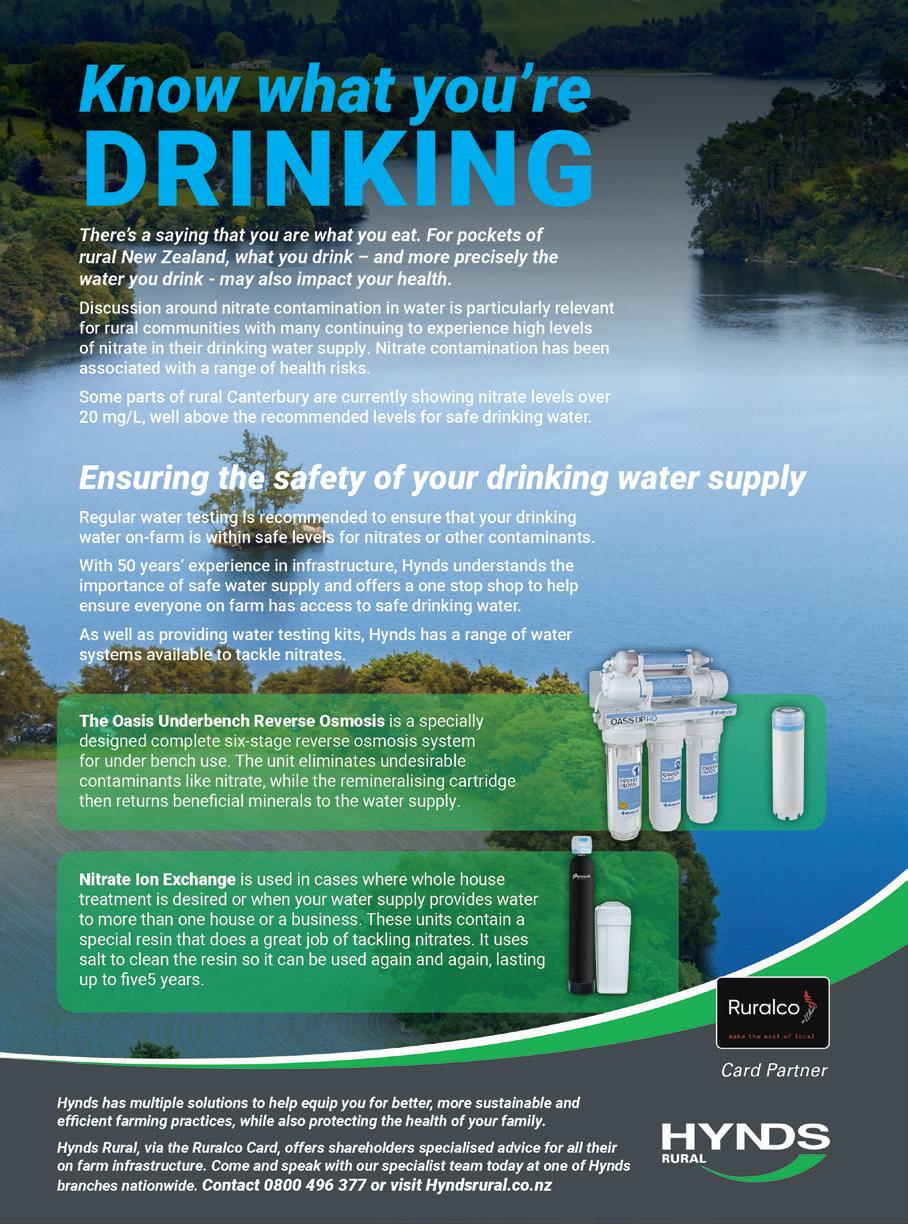

With the introduction of a duathlon event, new run/walk 5km course, a schools team mountain bike trophy up for grabs and the opportunity to ride the mountain bike tracks back the other way, the 2024 Ruralco Longbeach Coastal Challenge is getting it’s second wind. WORDS PROVIDED BY RACHAEL RICKARD, IMAGES PROVIDED BY SAM ANDERSON

From its’s inception in 2007 to the 10th anniversary event, the Ruralco Longbeach Coastal Challenge grew steadily in numbers, attracting new riders. As the numbers grew the committees of the time introduced new events, building the event from a single mountain bike ride to three mountain bike rides and three run and walk events which regularly attracted 8001,000 participants.
Over the past few years, the increase in the number of other events on offer, plus the cost of living have meant participants are spending more carefully. This led to a strategic review of the event, culminating in the organising committee for 2024 decided to refresh the new event, repurpose a trophy and introduce new courses to the offering.
Chairwoman, Rachael Rickard says “When we surveyed our community of volunteers, supporters and participants we were overwhelmed with support for the event, new ideas and a few home truths about what was on offer at other events that we need to add to be attractive. This saw us decide to introduce medals for every participant, revamp our registration packs and bring in more spot prizes.”
The committee also heard it was time for a refresh of the courses .“We’ve been going in the same direction for the past 16 events, and we were considering how to bring in fresh perspective. Then the thought occurred ‘why not ride back the other way?’. The more we discussed it the more excited we got about it. This is a community event and alongside being a fundraiser we have the goal of connecting our community. We hope to do this by having one prizegiving for the event. To achieve this mountain bikers will have an earlier start time, and we’ll lift and shift the 5km course away from mountain bikers, to ensure families and children aren’t clashing with bikes,” says Rachael. Over the years the committee has noticed athletes who come and run, then wait around for the mountain bike leg and then head out and do that. “We are aware there are many multisport athletes in our community who love a ‘next level’ challenge, this is where the two-stage duathlon of a 23km mountain bike, then 12km run, comes in.” If this wasn’t enough of a revamp, there is also the addition of a new trophy up for grabs for school teams. Over the passage of time the event has ended up with two corporate mountain bike trophies, one for each of the 35km and
23km rides. These have historically been a battle between teams from Ruralco, BNZ and Big Als Methven, which has been awesome. However, to attract a new breed of riders the 35km team’s trophy has been repurposed to the Schools Challenge Trophy which will be awarded to the fastest team of four in the 12km mountain bike ride. Teams of four students must be between Years 4–8 and the winning team will be the one who has the fastest first three riders over the finish line.
In addition to those out racing, competing, and completing, the event is supported by over 100 volunteers, from committee members, to catering on the day, to track preparations and management, to site management and sponsorship.
“There are a huge number of hours that go into making this event the success it is, and we are really excited to welcome you all to the 2024 event.”
New for 2024:
• We have added a Duathlon (23km mountain bike + 12km run)
• The 23 & 35km mountain bike courses will be ridden in reverse
• New 5km run course away from any bikers
• School Teams Challenge: Teams of 4 from Years 4–8 compete in the 12km mountain bike—first 3 competitors over the line is the official time
• All finishers will receive a medal
Registrations are now open! Visit www.longbeachcoastalchallenge.com
We’re social
Follow the event on Facebook and Instagram pages
This year’s event is being held on Sunday 24 November 2024

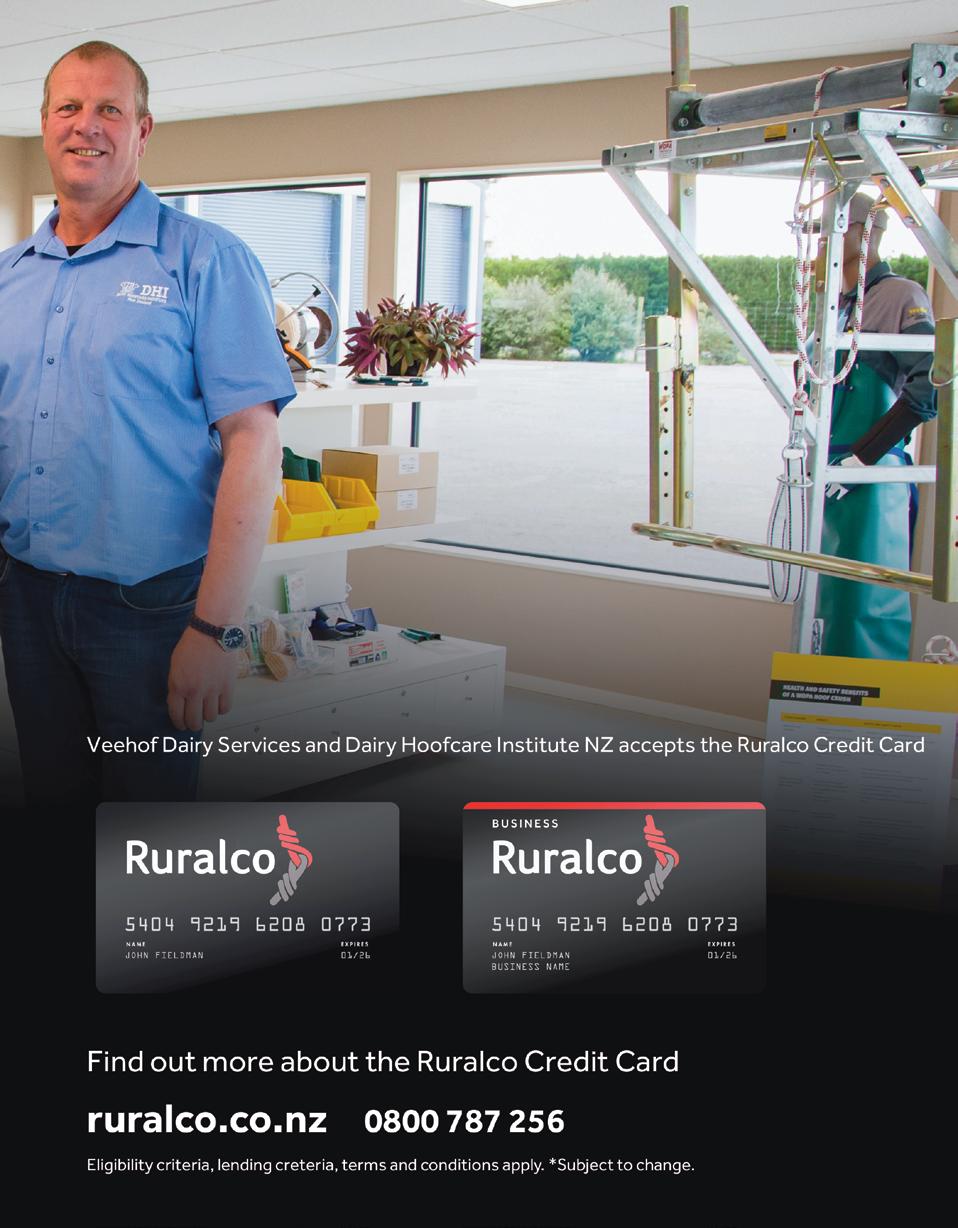

When you shop with Ruralco or a Ruralco merchant, you support your local community; that’s the mantra behind Ruralco’s Spend for Your School programme.
WORDS & IMAGES BY ANNETTE SCOTT
The initiative is part of the co-operative’s new strategic direction as it increases its effort “to make a difference that matters,” says Ruralco Chief Executive Tony Aitken.
“We’re local first. That means we’re making sure we give back to our local communities and the future farmers of Mid Canterbury.
“Our Spend for Your School programme offers our members the chance to win $500 for a primary school of their choice.”
Winning schools so far have included Mayfield Primary, Lauriston Primary, and Methven Primary, and each have greatly appreciated the extra money to help them deliver quality education to our local kids.
In a novel approach to give everyone a chance to have input, Mayfield School’s “how to spend
$500” was a decision made in consultation with all the children across all classes.
Mayfield was the first school to benefit from Ruralco’s Spend for Your School programme.
“It was exciting to get this donation and so I thought it would be a good idea to see how the children might like to spend it,” principal Aroha Stewart says.
“I asked the children what they love about their school and what they really wanted at the school, and they said a swing.”
“It was pretty cool really, the $500 became the catalyst for the swing project.” And a fundraising drive was started to reach the quote of $10,000 for a “sensor swing and a normal swing the $500 was a swinging start.”
Other fundraising has included a quiz night, and the school has applications in for funding with the hope of having swings in the playground before the end of the year.
“It really has been a good option. All the children wanted this for the greater good of everyone, and not just everyone now, but for
Tony Aitken, Ruralco CEO “
Primary schools are at the heart of rural communities, also in the heart of those communities are our future generations.”
future school children in the playground, for many children and many years to come.”
The children and teachers hailed a huge thank you to the Orchard family’s grandparents who nominated Mayfield School.
“We are very grateful to the family and to Ruralco and we encourage our school community to support this project and Ruralco,
this is a great project they have got going,” Aroha says.
Lauriston School was the second winner and “was very excited and grateful to receive $500 as part of the Ruralco Spend for Your School programme.”
Sport and recreation team leader Laura Twiss says the money was set aside to invest in the sports department and buy some new gear to help ensure permanent events take place throughout the year, such as Jump Jam, the winter sports tournament and athletics.
“Recently we have been able to purchase a new Jump Jam kit allowing us to learn new dance routines as part of our fitness programme and in preparation for the upcoming regional Jump Jam competition that takes place in Christchurch.”
Inspired by a previous regional win in 2017, and a third placing last year, Jump Jam has become a huge part of Lauriston school.
“It is awesome to have so many students involved especially now we have the latest kit; we are really ramping up with more students encouraged to get involved this year.
“We select the routine as a team at school.
Students will be given a Jump Jam t-shirt to wear on stage as part of their entry fee, which they can keep. With our new kit we are right up there.”
After the Jump Jam spend there is still $100 left to spend on new basketballs for the upcoming mini ball competition and some new athletics equipment.
“Thank you so much Ruralco, and to our Ruralco member Sue for nominating us.”
Methven Primary School is the third winner of the Spend in Schools programme with plans to stock up on indoor games for wet day entertainment in the library.
“We have a huge thank you for Ruralco and to the local family that nominated us for the $500, this is all extra funds that will help provide resources and opportunities for children right across the school,” Principal Sue Furndorfler says.

Methven has tagged the $500 for a spend in the library as new ideas transform the library space for more use over the winter months.
“We have a new librarian, Rachel Brown, and she has new fresh ideas.”
These include opening the library every lunchtime and with a growing school roll, stocking up with new books and indoor games.
“We looked at the games and really, we have very few in the way of board games and the like, for students to utilise on cold and rainyday lunch times, so the $500 is tagged to stock up on learning and educational indoor games.
“Mrs Brown is training up a student librarian and focusing towards running the library like a lunchtime club with the older children taking a lead.So, thank you Ruralco, this money will be spent for the children of the community who will benefit for many years.”
Winners of June was Wakanui Primary and July Mayfield School again.
“It’s been great visiting the winning schools, connecting with our people, and being able

ABOVE: Methven primary students Gia Song, Tama Watene and Nila Hapuka piece together a puzzle while Saumya Soni and Alex McConnell test their skills at Connect Four in the soon to be replenished games section of the school library
BELOW: Lauriston school jump jammers practice new jump jam moves with money to spare after the purchase of their new jump jam kit tagged for new sporting equipment
OPPOSITE: Mayfield School Tamariki are excited the Ruralco’s Spend for Schools $500 has kick-started their eagerly awaited playground swings project
to support our locals at a grassroots level,” says Tony Aitken.
“Primary schools are at the heart of rural communities. Also in the heart of those communities are our future generations, and we are helping to improve education and opportunities for our kids.”
Spend for Your School is also aimed at encouraging people to use the Ruralco Card more with local merchants. The programme gives away one $500 cash prize every month for the 2024 calendar year, with qualifying merchants including all businesses that accept the Ruralco Card for payment, including Ruralco retail stores.
“This is another way we connect with our local community. It fits why we are a co-operative, we put money aside each month to give back to our locals,” says Tony.
Every 10 transactions with their Ruralco Card gets members one entry into the prize draw to win $500 cash for an Ashburton school of their choice.
“The more you use the card the more chance you have to support the local schools, and it’s entirely the school’s choice how they decide what is best and how they spend the money.
“Simply spend on your Ruralco Card to go in the draw. Plus, you get great discounts and real value when you choose to use your Ruralco Card, which gives you the opportunity to support your nominated local school to the tune of $500.”







IMAGES PROVIDED BY BEEF + LAMB Ewes
The ‘holy grail’ is a ewe flock that lambs in good condition (no ewes under BCS 2.5 and most ewes at 3.0-3.5), that is well fed in the weeks leading up to lambing and lambs onto feed that enables maximum intake in the critical early weeks of lactation.
Where ewes are managed as close as possible to these targets, the impact of worms on production is negligible. The amount of planning and work that goes into securing this outcome should not be underestimated. The process begins at weaning the previous summer.
The further away a farm is from these ideals at lambing time, the more likely that there will be noticeable responses from treating ewes with longacting drench products. This common outcome suggests many farms have a significant opportunity to improve production by focussing on ewe body condition and autumn/winter feed management. Long-acting pre-lamb treatments are an established risk factor for accelerating drench resistance. It is very common for them to be ‘leaking’ worms whilst animals are under treatment. Check for this by taking faecal samples during the pay-out period (docking can be a convenient time). A faecal egg count will reveal the extent of any leakage. An ‘exit’ drench may then be necessary to clean out resistant worms, or further samples may be required.
Undrenched ewes are an important source of refugia (where worms that are not drench survivors contribute some eggs to the pasture to help ‘dilute out’ resistant worms). Lambing some untreated ewes in amongst treated ones can help provide some refugia.
Lambs start to ingest parasites from the moment they begin nibbling grass. However, there is no need to administer worm treatments to lambs in their early weeks of life:
1. Egg-laying worm populations generally don’t establish in lambs until after they have become functioning ruminants (chemical signals in the ruminant digestive tract stimulate worm larvae to develop through to adults).
2. The majority of the production loss associated with worms (reduced appetite, reduced growth, and scouring) results from the lambs’ own developing immune response to gut worms, and this is absent in the early weeks of life.
Thus, a docking drench to lambs is typically unnecessary.
In some parts of the country, it is common practice to give lambs a drench pre-weaning. Where this practice has been evaluated by on-farm trial work, the results are inconsistent.
There is not always a liveweight gain response to a drench prior to weaning.
The factors that determine responses to a preweaning drench are probably similar to those that drive ewe responses to pre-lamb treatments: Light, underfed ewes lactating on short pastures will have lower peak milk production and a shorter lactation – thus ewes and lambs move into competition for pasture (clover) with each other earlier in the spring. In this situation, lambs are more likely to be impacted by parasites.
Once lambs are docked, there are more options for grazing management to increase feed to ewes and lambs, which can offer greater benefits than a pre-weaning drench. Examples are putting lambing mobs together and starting a rotation, pinching some cattle paddocks for ewe and lamb mobs, creep grazing of lambs; even selling ewes with lambs at foot to lighten the load and improve feed availability for the remaining ewes.
We are now in an era where the ‘routine’ initial drench used for many years may well be allowing significant numbers of worms to survive. If a farm has not completed drench efficacy testing, this situation will be unknown.
At the very least, perform a ‘drench check’ on your first lamb drench. This involves a faecal egg count on 10 fresh samples collected from treated lambs 7–12 days after drenching. If there are significant eggs leaking through, it is time to seek expert advice and make a worm management plan for the summer and beyond.
ABOVE: Tailing: A lamb drench at tailing is usually unnecessary
BELOW: Ginny Dodunski, Beef + Lamb New Zealand’s Wormwise Programme Manager



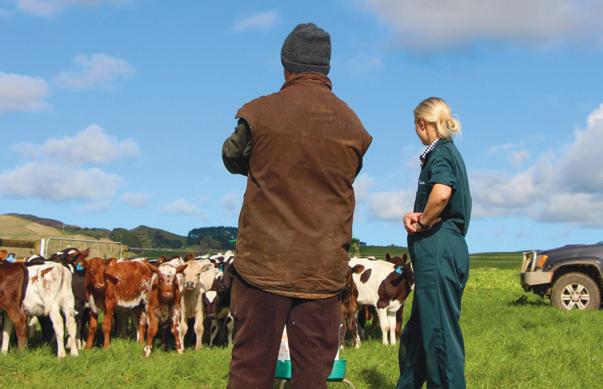
Now spring is here, and we have another winter under our belts it is time to welcome some sunshine and spring grass growth to keep the cows milking and the calves growing. It’s not only us farmers, our stock and the pasture that enjoy some warmer spring weather, the parasites do too and now is a good time to reassess your young stock drench programme.
Growing young stock well is essential for lifelong performance in the dairy herd, and parasites can be a leading cause of poor growth rates in young cattle if they are not well managed. When considering calf drenches three factors need to be considered.
• Calf weight: Calves under 100kg are susceptible to Abamectin toxicity so drench combinations including this should not be used in this weight group.
• Age: cattle under 12 months require Levamisole to target Cooperia worms, so all calf drenches must contain this drench component.
• Oral drench is best.
For calves that have been on pasture for 4 weeks or more and require their first drench, consider Active + Merge, a 1mL/10kg oral drench of Oxfendazole and Levamisole. Merge is a safe and effective choice for calves under 100kg. After weaning and when calves are greater than 100kg, a triple combination oral drench, such as Active + Treble, is recommended. Heifers being mated for the first time may also require a spring drench for parasites to help achieve the best
condition and hit mating target weights (Dairy NZ recommends 60% of mature cow LW at mating). When choosing a drench for this stock class, an injection is preferable over pour-on, but opt for one containing an ML drench to target Ostertagia, such as Horizon Doraject injection containing Doramectin. R2 bulls should also be included in this treatment group.
Should any light cows or first calvers require a parasite knock down premating Active + Epi has a convenient nil milk withhold so it can be easily given prior to PSM.
As always, when drenching stock, it is important to weigh a sample of the mob and drench to the heaviest animal. Calibrating your drench guns using the drench you intend to use, and reliable measuring cylinders is also an essential component of drenching, as under or overdosing can be costly mistakes that are easily avoidable.
As drench resistance becomes more prevalent, we recommend taking a 10-day post-drench
IMAGE: Annika Ferris, Agritrade Technical Expert, Animal Health, on farm inspecting stock
faecal egg count to monitor the effectiveness of your drenches. Ensuring a minimum of 28 days between drenches is important to give time in the worm life cycle for a population of “undrenched worms” to be present for refugia and aids in slowing the progression of resistance. Where possible using forage crops, cross grazing with other species and maintaining high grazing residuals are all good tools for reducing larval intake and lowering the need for drenches.
Maintaining overall calf health enables calves to build a strong immune system and tolerate a mild worm burden so again there is less reliance on drench to prevent parasitism. Multimineral injections such as Horizon InjectaMin or InjectaMax (with B12) help boost the immune system and can be given up to every three months to help boost young stock growth especially at times of stress such as weaning. These multimineral injections also benefit cows and heifers prior to mating by boosting their immune systems with Zinc, Selenium, Copper, Manganese, and B12 which are all essential for a robust immune system and fertility. Copper and Selenium can both be toxic when given in excess so if you have already supplemented copper via a bullet or injection and want a Copper-free option for a premating boost, consider Horizon Cobalject B12 (1000 or 2000) injection that has the option of additional Selenium.
To build a drench programme for your young stock this spring and to get the best out of your cows this coming mating, talk to your Ruralco representative or visit your local store today.
THIS PROMOTIONAL FEATURE WAS PROVIDED BY AGRITRADE
ACVM #s: A011494, A011925, A011491, A011495, A011926, A010717, A011690, A011692, A011694 & A011969
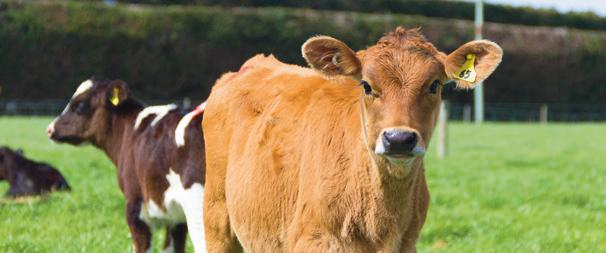


Trusted in the Canterbury region for more than 90 years, Newlands Group Limited has recently teamed up with iconic Australian 4x4 accessories brand ARB, bringing their extensive range of products to its branches in Ashburton, Rolleston, and Timaru.
WORDS & IMAGES BY ANNIE STUDHOLME
Now in its third generation, Newlands was founded in 1933. Established as an autoelectrical and battery service centre, the business later diversified into installing, fixing and servicing vehicle air conditioning systems. Robert Newlands, a grandson of Newlands’ founder Bill Newlands, expanded the sales side of the business in the early 2000s, joining the Powertool Centre Group and building a new showroom on its current site. The company continued to grow with the opening of its Rolleston branch in 2010, followed by the purchase of Timaru Battery Service and Ace Automotive. Newlands Timaru was formally established in 2020 after the company relocated Timaru Battery Service to Washdyke. Today, Newlands Group Ltd employs 65 people across its three branches. It provides an auto electrical and air conditioning repair facility, utilising the latest electronic scanning equipment for fault diagnosis and repairs. It also has a fleet of fully equipped service vehicles for on-farm repairs and stocks an extensive range of vehicle batteries and parts. In addition, it also stocks
a great range of auto parts and accessories; power tools (including Makita, Bosch, Milwaukee); Knipex hand tools; Tait, Hytera and GME land and marine radios; EROADS GPS; car audio and reversing cameras sales and installation; Hella LED lighting; and KT Solar and lithium batteries, among others.
Though Newlands has firmly established itself as one of the country’s leading auto electrical service centres and a proven place for farmers and the service industry alike to do business, General Manager Sales and Director Jeff Naish says the team felt something was missing that linked all facets of the company together. “The move into ARB is the link we have been searching for,” he says. With its origins going back to 1975, when company founder Tony Brown was inspired by a 4WD driving trip through the top end of Australia, ARB has become Australia’s largest manufacturer and distributor of 4x4 accessories with offices across the globe. Above all else, it is built on quality, reliability, and practicability, and substantial capital is invested into research and design each year. ARB’s range includes everything from bull bars and snorkels to rooftop tents and camping essentials, suspension and underbody protection, floor mats and lighting bars, to name a few.

Having seen how popular ARB accessories had become in Australia, not just with diehard 4x4 enthusiasts but also with farmers and the trade industry, Newlands saw bringing them to Canterbury as a massive opportunity. While some ARB stockists were already in New Zealand, most were in the North Island, explains Jeff.
“It’s a premium product, and its range complements what we already have but gives customers even more choices. There is something for everyone in their product line. It’s a great fit for us as our customer base already use some sort of product from their range. It also simplified much of our stock handling as we only have to deal with one supplier.”
After almost a year in the making, Newlands officially became an authorised stockist and installer of ARB accessories last September.
“It’s very exciting. The staff are intrigued and interested, which makes it really easy. Everyone is passionate about the products and enthused by the product line. We have already established a great relationship with ARB. As a business, we have invested heavily in the product, including stock and display material. We are very excited to see what the future brings,” says Jeff.
ABOVE: General Manager Sales and Director Jeff Naish BELOW: Newlands on

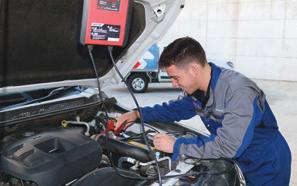


Introducing Agricom’s smartest grass yet. Align AR37. Our new, extremely late heading, tetraploid perennial ryegrass revolutionising the tetraploid game.
This impressive edition to our ryegrass portfolio introduces a rare style of tetraploid genetics characterised by dense, highly tillered, leafy plants—resulting in resilient, productive pastures all year round. Bred to meet the unique challenges of New Zealand’s diverse agricultural landscape, farmers can expect an adaptable grass, that will excel in any sheep, beef or dairy system. Coupled with AR37 endophyte, you can expect increased persistence, even in some of New Zealand’s more challenging growing conditions.
Align is a powerhouse, renowned by the Agricom agronomy team for its exceptional productivity across challenging summer, autumn and winter seasons. Aligns ability to remain in a vegetative state throughout summer—showcasing low aftermath seedhead and exceptional rust tolerance puts it in a league of its own and sets it apart as a vital asset for any kiwi farmer seeking resilient high-performance pasture. This summer performance and pasture quality allows dairy farmers to maintain peak lactation as long as possible, while these same traits provide sheep and beef farmers with high quality pasture for newly weaned lambs to perform at their best. Throughout winter, Align’s dense nature provides winter resilience not normally associated with tetraploid pastures.
“Align is one of the healthiest and most productive ryegrasses I’ve experienced and it comes at a great time for producers trying to maintain productive efficient farm systems” said Allister Moorhead, Agricom’s Product Development Manager.
Agricom’s extensive trial network has seen Align currently enter 36 internal trial locations across the country from Northland to Southland, of which 22 are yielded. This commitment ensures that you can have confidence that Align AR37 is a consistent, reliable, top performer across a variety of regions and farm systems. If you are looking for a grass backed by research, data and innovation look no further than Align AR37.










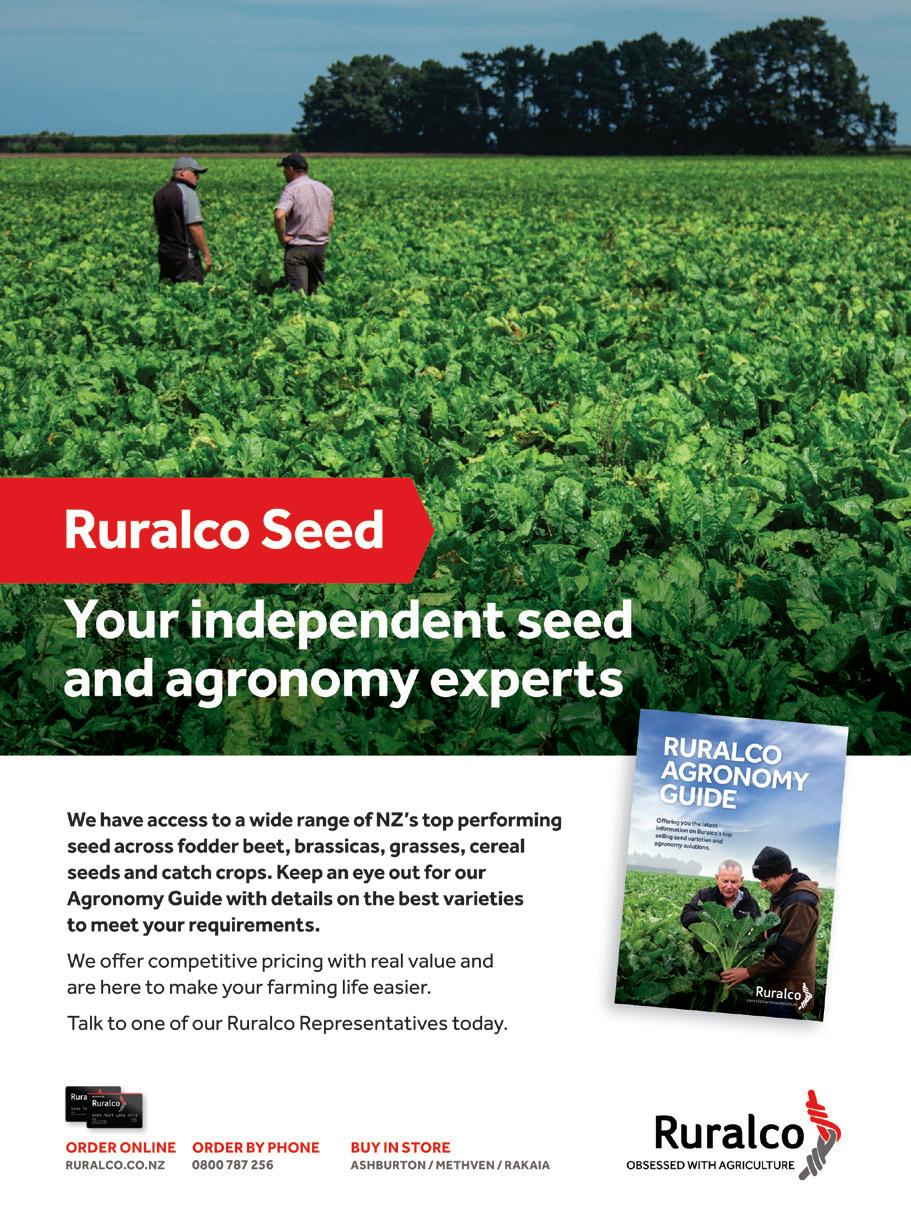





For over three decades, Ngahiwi Farms has been synonymous with quality in the calf milk replacer (CMR) industry.
As a fourth-generation farming family, we understand the demands of farming because we live it every day. This connection to the land and the farming community drives our commitment to producing the highest quality products, backed by unmatched service and a deep respect for our clients.
A proud heritage of quality and innovation
Ngahiwi Farms has been manufacturing calf milk replacers since the 1980s. What began as a small operation trading raw ingredients has grown into a trusted and reliable brand. We’ve evolved alongside the calf-rearing market in New Zealand, working closely with all the major dairy companies to transform raw ingredients into the perfect product for your young animals.
“Our journey began almost 40 years ago when I started trading milk ingredients with a few local farmers who were rearing calves in the Waikato” says Bill Coates, the founder of Ngahiwi Farms. “Demand grew naturally from there, and what started as a simple exchange turned into a lifelong passion, building a business in the industry I love: farming.”
“My whole life has been based around farming. My family grew up around farms; the boys travelled with me to see clients, drop product to farms, packed bags in the school holidays, it has been a family affair, and we’ve loved every minute of it,” remarks Bill.
A comprehensive product range tailored to your needs
Ngahiwi Farms manufactures all our products in-house, ensuring that every bag meets our
exacting standards. Each product is made under the watchful eyes of Bill and Will Coates, with quality always at the forefront of every decision. Our flagship product, Ngahiwi Premium CMR, is designed to optimise and accelerate calf growth. This formula combines a wellbalanced mix of proteins and fats with probiotics, prebiotics, essential oils, vitamins, minerals, and a coccidiostat to give your calves the best start possible.
“We take great pride in the quality and consistency of our products,” says Will Coates, General Manager of Ngahiwi Farms. “Our Premium CMR is not just another milk replacer; it’s a carefully crafted formula designed to support the health and growth of calves right from the start.”
In addition to our Premium CMR, we offer a Supplementary CMR, perfect for fortifying whole milk or as a stand-alone powder for colostrumproven calves.
To further support your herd’s health, our Re-Nu Electrolyte range, available in 3kg and 10kg sizes, is crafted to meet the needs of both small-scale farmers and large operations, ensuring that your calves stay hydrated and healthy during critical stages of growth.
“Our products are designed with the farmer in mind,” adds Will. “Whether you’re raising a single calf or managing a large operation, we’ve got a solution that fits.”
Ngahiwi Farms is proud to supply farmers from Kaitaia to Invercargill and everywhere in between. Our commitment to quality and consistency means that no matter where your farm is located, you can rely on us to deliver the best products for your livestock.
At Ngahiwi Farms, we believe in backing our products with solid research. We’ve always been committed to understanding the needs of farmers and the best practices for calf rearing. Our involvement in various trials has provided invaluable insights into feeding regimes and calf health, which have informed our product development over the years.
“We’ve seen the benefits of different feeding systems and have integrated those findings into our products,” says Bill. “It’s all about ensuring that our customers get the most out of their investment in their calves.”
Our relationship with Ruralco has been instrumental in our success in the Canterbury region. Ruralco’s dedication to their clients mirrors our own, and we’re proud to partner with an organisation that shares our values. The loyalty that Mid Canterbury farmers show to Ruralco is a testament to the quality of service they provide, and we’re honoured to be a part of that relationship.
“We’re not just another supplier; we’re a partner you can rely on,” says Will. “We stockpile our products in Ashburton to ensure they’re available when you need them most, especially during the busiest times of the year.”
Commitment
At Ngahiwi Farms, we believe that our success is built on the success of our clients. That’s why we offer more than just products—we offer a partnership. When you call us, you’re speaking directly to the owners, not navigating through a maze of admin and sales reps. Like farmers we don’t do annual leave or sick days, it’s this personal touch, combined with our commitment to quality, that ensures that you receive the support and products you need to succeed.
“Being accessible to our customers is something we take very seriously,” says Bill. “When you pick up the phone, you’re talking to someone who understands your challenges because we’re farmers ourselves.”
Ngahiwi is dedicated to refining our offerings and expanding our product range to meet the evolving needs of farmers. Our focus on quality, innovation, and service has made us a trusted name in the industry, and we look forward to continuing to serve the Mid Canterbury region with pride.
THIS PROMOTIONAL FEATURE WAS PROVIDED BY NGAHIWI FARMS



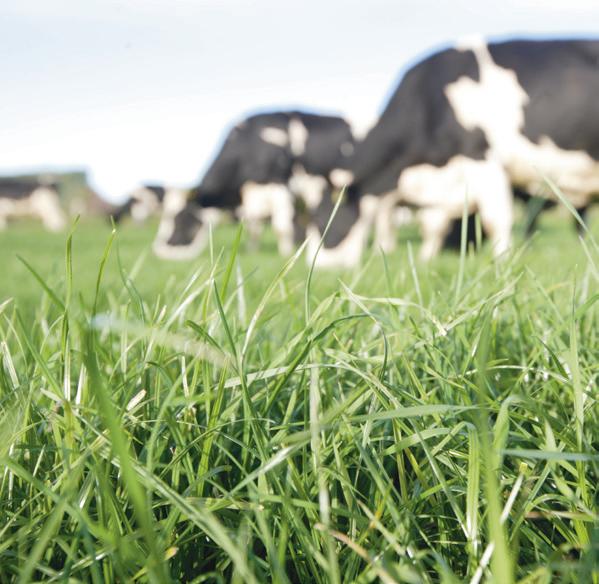
It’s disappointing when ryegrass fails to live up to its promise, leaving farmers frustrated and weary of perennial cultivars.
We understand that resowing perennial ryegrass is a significant investment and Kiwi farmers and agronomists demand enduring, high-yielding performance for the lifetime of the cultivar. They also seek reliable assurances against common issues such as ryegrass staggers and insect damage. Taking onboard this feedback, we’ve developed Stampede diploid perennial ryegrass with the innovative CM142 endophyte.
The journey to Stampede CM142 has been one of perseverance. Developed by Cropmark’s breeding team in Canterbury and incorporating insight from farmers, Stampede represents many years of research and insight to combine New Zealand’s best ryegrass genetics with a new and unique novel endophyte.
Stampede CM142 is more than just another ryegrass cultivar says Cropmark’s plant breeder Stephane Montel. “This late heading diploid perennial ryegrass boasts consistent yield
performance validated through rigorous on-farm trials across New Zealand and Australia. It’s a very nice-looking grass, dark coloured with very high tiller density to improve its persistence and ensure a reliable source of high-quality forage throughout the year”.
Central to Stampede’s remarkable resilience is the CM142 endophyte, a ground-breaking discovery with origins tracing back to the harsh alpine regions of Greece. Harnessing the natural insect deterrent capabilities of Epoxy Janthitrem alkaloids, CM142 combined with Stampede’s robust genetics “offers a natural defence mechanism to increase pasture persistence, which is a key attribute for perennial pasture” says Stephane. “Our main effort in developing CM142 was to maintain the component around insect protection while increasing livestock performance, due to lesser toxicity and better forage production”.
However, the benefits of Stampede extend beyond pest resistance. “CM142 has consistently shown a reduced potential to induce ryegrass staggers and heat stress. We believe this is a result of its unique alkaloid levels” says Stephane. Cropmark says that Stampede will be commercialised this spring. In anticipation of its launch to the market, seed has been distributed to participating livestock farmers throughout the country to further assess its on farm performance. “It’s a great achievement for the team and the wider industry” says Stephane, “with innovation from a New Zealand owned company that provides farmers an alternative to support them in what they do best”.
For further information contact your Ruralco representative.
THIS PROMOTIONAL FEATURE WAS PROVIDED BY CROPMARK SEEDS.
BELOW: Cropmark Seeds Trials Manager Richard Moate (left) and Technical Manager Matt Deighton (right) inspecting Stampede in c trials
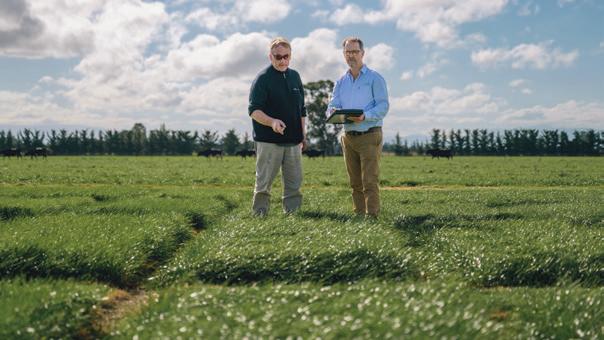
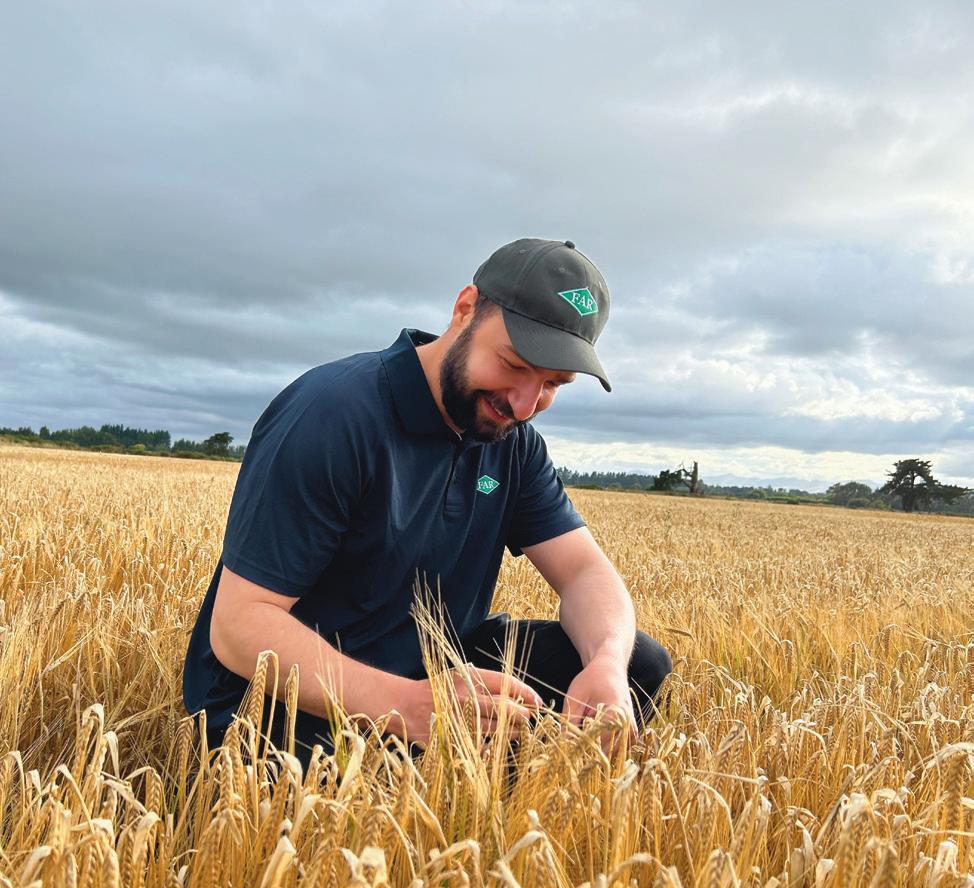
While monoculture crops have become the norm, this wasn’t always the case.
WORDS & IMAGES PROVIDED BY THE FOUNDATION FOR ARABLE RESEARCH
Going back more than a century, multiple cultivars of the same species were commonly grown together in the same paddock, a cultural practice that is again attracting the attention of researchers and growers.
Foundation for Arable Research cereals researcher Andrei Costan says that mixes have the potential to reduce disease pressure and spread, as well as increasing yield stability,
and have been implemented with great success, particularly in cereals.
A three-way winter-sown feed wheat mix has been trialled by FAR at its Chertsey Arable Research Site near Ashburton, and some growers are also trying mixes.
At FAR’s Future Farm Systems Demonstration site at Chertsey, a three-way feed wheat mix was sown on the future farm side in autumn. This was an equal mix of three different cultivars, Voltron, SYDefiant and Graham, with the seed coated with Trichoderma. In contrast, the conventional side was only sown with Graham wheat.
A diversity of plant genetics in a paddock helps to reduce the rate of spread of pathogens
compared with a traditional monoculture crop, Andrei says. “It creates a multiple gene obstacle course.”
“Cultivar mixtures have been successfully employed to steward disease resistant cultivars and at-risk chemistry, and to increase within-field diversity.”
No difference in management practices is required between the mixed and monoculture plantings, apart from the initial mixing of cultivars at sowing, with chemical inputs remaining the same.
There is no penalty in seed quality, and research shows a tendency for a minor yield increase with the three-way mix, mostly as a result of lower disease pressure, Andrei says.

However, farmers need to make sure they can market their harvest, as some mills may be hesitant to accept wheat mixtures, though this is less of an issue for feed wheat, destined for the dairy and poultry industries.
Another important consideration is making sure that the cultivars included in the mixture are compatible with each other, particularly in terms of time of ripening. Mixing early and late cultivars may result in premature shattering or the grain sprouting in the head (preharvest sprouting).
FAR research has focused on a mix of three cultivars, with data showing mixes of between three and six are possible. “Above six, there is little benefit from adding further cultivars for the work involved.”
A major obstacle in obtaining good wheat yields in New Zealand is disease control, with pathogens such as Septoria tritici blotch (STB) or leaf rusts causing severe yield losses if left unchecked.
As a result of challenges to arable farming, including increased pathogen resistance to fungicides and fewer new ag-chemicals becoming available, cultivar mixtures have seen a resurgence of interest. For example, in France, the use of wheat cultivar mixes rose from 1 per cent of the total wheat cultivated area in 2010 to more than 11 per cent by 2019. Overseas research shows that when growing a mix, two-thirds of the selected cultivars should be resistant to the target disease and the other third more susceptible.
Sowing cultivars with different disease ratings in a mixture has several functions. Not only
does it increase in-field diversity, but also the more resistant cultivar within the mixture can slow disease development, which in turn allows for flexibility in fungicide programme choice. This flexibility may help slow resistance development for at-risk chemistry. In addition, the inclusion of multiple cultivars relieves pressure on the more resistant variety, which can help reduce the risk of cultivar breakdown.
LEFT: A drone view of the irrigated mixed-wheat cultivar trial at FAR’s Chertsey research site
BELOW: The dryland mixed wheat cultivar trial at FAR’s Chertsey research site
OPPOSITE: FAR cereals researcher Andrei Costan says that cultivar mixes are an option, particularly in cereals
“If you mix together cultivars that are all resistant, this gives you the short-term benefit of disease reduction, but long-term you’re not really protecting the cultivars as much,” Andrei says.
From 2021, FAR carried out a three-year winter wheat cultivar mixture trial under irrigated and dryland conditions at Chertsey, funded by the SFFF “A Lighter Touch” programme. Three cultivars with different disease ratings to STB and rust were sown as a mixture in equal proportions. These were: year one - cultivars Firelight, Starfire and Graham; year two - Starfire, Firelight and Reflection; and year three - Starfire, Voltron and SYDefiant.
This showed that growing wheat cultivars in a mixture is an effective disease suppression method, regardless of whether the problem pathogen is leaf rust or STB.
“Thus, farmers who are growing feed wheat can consider cultivar mixtures as an option that will allow them to steward both at-risk chemistry and disease resistant varieties.
“Given the promising results, this opens up the possibility of future work, where we could test to see what the optimum number of cultivars is to include in a mixture, as well as what’s the best disease rating combination,” Andrei says.





YOUR TRAVEL GUIDE
Escape in Spring with a weekend away. Venture to the coast of Banks Peninsula, escape in Mid Canterbury, or nestle into the rolling hills of Southland.

If you are looking to get away from the rat race and enjoy the quiet, uncomplicated, country air, or maybe take time out on a working farm or fancy a spot of fishing in one of New Zealand’s revered trout and salmon rivers, then The Whare is the place to come. The Whare is more than a bed for the night—it’s an experience!
Nestled in its own idyllic oasis, Paddy’s Pod is a selfcontained off-grid curved cabin radiating charm with breathtaking views of Mt Somers and Mt Hutt. Just outside your door, a large pond, graced by the occasional swan is a serene setting for a relaxing stay.
A fusion of Scandinavian chic and bespoke craftsmanship, The Tommy House is the ultimate getaway for couples. Set amongst breathtaking views of a multi-environmentally award-winning farm in Southland.



With the campsite only a 15-minute meander (or 3-minute drive) down to a beautiful, secluded beach, glamping at Lavericks Bay on Banks Peninsula is something special. Rich in history, the scenic bay is set on a 1,000 hectare sheep and beef farm, which has been in the same family since the 1850s.
INGREDIENTS :
Venison backsteaks (mince, chicken, or fish are also fantastic)
Wraps or tortillas
Lettuce, shredded
Diamond rice risotto mix (optional)
Your choice of salad toppings: avocado, tomato, avocado, onion, zucchini, capsicum
Your choice of dressing: ranch, aioli, BBQ, sweet chilli
METHOD:
Make Diamond rice risotto as per packet instructions.
Cook your backsteaks to your preference, seasoning with salt and pepper. Microwave tortillas until warmed through (approximately 10-15 seconds).
Slice salad toppings (tomato, lettuce, capsicum, and avocado) and set aside to serve.
Once venison and risotto are cooked, spread out wrap and top with shredded lettuce and risotto.
Add your salad toppings and your venison backsteaks. Drizzle with sauce, and fold wrap.




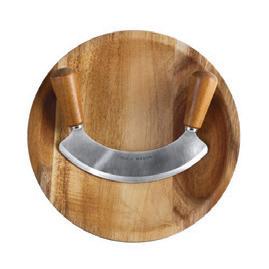



Minx is a modern, bright, airy salon located on the main street of Ashburton, and is the home to four Senior Stylists and two aspiring apprentices.
We are a team that specialises in colour, thrives off continuous education, and making positive changes in our industry.
We are proudly partnered with Sustainable Salons. This means we ensure up to 95% of our salon waste is recycled and repurposed.
OUR BIGGEST TIPS FOR GETTING THROUGH SPRING ARE:
An anti-frizz serum can be simple step in your routine to help prevent tangling when out and about and provide humidity defence on the warmer spring days. 1 2 3 4 5
Book in for a treatment to renourish the hair and trim the split ends. When split ends are left, it can make the hair look fluffier and lead to more split ends.
If you’re a blonde—a maintenance toner is the perfect way to refresh and gloss your hair.
If you’ve been in the yards or the calf pens, a clarifying shampoo can be a great addition to help remove any build up that may have snuck in.
Protect your hair—always. Whether your heat styling, or a wash-and-go kind of gal, a product like One United is a multi-beneficial spray that will have you covered in every area.

BY SHILO KINO
Meet Māreikura Pohe: she’s in love with her best friend, though he’s about to abandon her; and she’s an accidental activist, though she never asked for the spotlight. Navigating self-diagnosed ADHD and a new relationship while reclaiming her language is no easy feat. But as her platform grows, Māreikura unwittingly becomes a voice for change against the far-reaching consequences of colonisation. The question remains: at what personal cost?

BY TRACY CHEVALIER
It is 1486 and Venice is a wealthy, opulent center for trade. Orsola Rosso is the eldest daughter in a family of glassblowers in Murano, the island revered for the craft. As a woman, she is not meant to work with glass—but she has the hands for it, the heart, and a vision. When her father dies, she teaches herself to make beads in secret, and her work supports the Rosso family fortunes.

USE YOUR RURALCO CREDIT CARD HERE



BY DAN CARTER
A unique and inspiring deep dive into leadership, strength and resilience from one of sport’s true masters: All Black legend Dan Carter.
You might think success at the highest level insulates you from pressure and doubt. But nothing could be further from the truth.
BY KARIN SLAUGHTER
Welcome to the McAlpine Lodge: a remote mountain getaway, it’s the height of escapist luxury living. Except that everyone here is lying. Lying about their past. Lying to their family. Lying to themselves. Then one night, Mercy McAlpine—until now the good daughter—threatens to expose everybody’s secrets. Just hours later, Mercy is dead. In an area this remote, it’s easy to get away with murder. But Will Trent and Sara Linton—investigator and medical examiner for the GBI—are here on their honeymoon. And now, with the killer poised to strike again, the holiday of a lifetime becomes a race against the clock...





The government is currently discussing several proposed relaxations on resource management rules. These changes include balancing the Te Mana o te Wai hierarchy with water needs, modifying freshwater farm plans, and reducing the requirement for consent for on-farm and orchard water storage.

Te Mana o te Wai was a framework that was designed to balance the needs of the life force of the river (including the biodiversity that exists within it). It also balanced the needs of humans for drinking/kai gathering, recreational pursuits, and the productive uses for growing food and green spaces.
The hierarchy has good intentions; however, I don’t know any food producers who don’t want the water bodies that support their crops, sustain rivers, and benefit the community.
Having bottom lines that then exclude human activity including drinking, was fraught when there were no other means to resource it.
By balancing these needs and continuing to set targets to improve over a generation, all areas can be provided for.
However, this must be coupled with the ability of farmers and growers to store water, ensuring that water bodies receive the necessary supply when needed. Allowing water storage as a permitted activity not only simplifies the process but also encourages investment and improvements in farm systems because to truly balance the requirements, we need to be able to support the flow of water and even supplement it when it’s dry.
These are the issues being addressed in the proposed changes to the Resource
Management Act. The aim is to support water bodies in replenishing and thriving while also doing the same for communities. This involves finding a balance within the Te Mana o te Wai framework, alongside provisions for water storage and improvements to freshwater planning.
IrrigationNZ is advocating for these balanced approaches to ensure both environmental health and community well-being.
We hope to see the outcomes of the current submission process very shortly.






Right now, on dairy farms around the country, farmers are managing feed, animals, budgets, machinery, and weather. They’re having conversations with their bankers and insurers and finding time for their kids.

That is just life for farming families, and everyone has to balance their own challenges.
WORDS & IMAGES PROVIDED BY DAIRYNZ.
In the background for farmers, as with other industries, are pending political cycles. These can bring changes to regulation, uncertainty while policy is decided upon, and a disconnect between national and local level while decisions are made.
To paraphrase Nuffield Scholar Kylie Leonard, it’s best for farmers to be at the table, rather than on the menu.
DairyNZ is an industry-good organisation, representing all 10,600 dairy farmers.
Our duty is to help keep them and their farming businesses moving forward.
In the past nine months of a changed government, we’ve seen several policy changes begin to roll out, including methane targets, agriculture out of the NZ ETS, further reform of the RMA, and the beginnings of a new pastoral sector group.
Much of this we’ve advocated for on behalf of farmers, and we welcome it - particularly in a time of high inflation and input costs. It is our job to keep engaging, and we do so with information
supported by world-class scientists and farm system expertise.
We are submitting on behalf of farmers regarding climate targets and emissions reduction plans, immigration and workforce development, the Biosecurity Act and freshwater standards.
We are also following closely impending government changes to genetic technology regulation.
We do what we can to help get bipartisan support for regulations that are logical and support good farming practices. Hopefully, we can solidify those rules and not have them disrupted every few years.
DairyNZ has 17 years of science and research to specifically benefiting dairy farmers. It is important we share our knowledge with decision-makers to ground policy in reality.
Much of our knowledge aligns with the realities of the global market, which is changing the way we farm.
Just recently, at the Primary Industries NZ Summit, we heard from Rabobank that 80 percent of Zealand’s exports are destined for countries with mandatory climate-related disclosures either in force or on the way.
New Zealand dairy farmers have always innovated and will continue to do so.
This is the basis of New Zealand’s prosperity, and today we stand proud as an internationally competitive dairy farming nation.
We produce over 20 billion litres of milk a year and bring in $25 billion in export revenue. Dairy employs 55,000 people and last year accounted for about 36% of all New Zealand’s goods exports.
New Zealand dairy farmers have a solid reputation as producers of safe, low-emissions, high-quality milk who uphold the highest standards of care for animals and environment.
The success of dairy underpins the success of the New Zealand economy and the wellbeing of New Zealanders.
At the end of the day, farmers and politicians surely have a similar end goal – a prosperous, safe, secure country with strong links to the outside world.
It’s good to be at the table so that, on behalf of our farmers, we can chart a more enduring course for sustainable growth.
Because at the end of the day, when dairy does well, New Zealand does well.
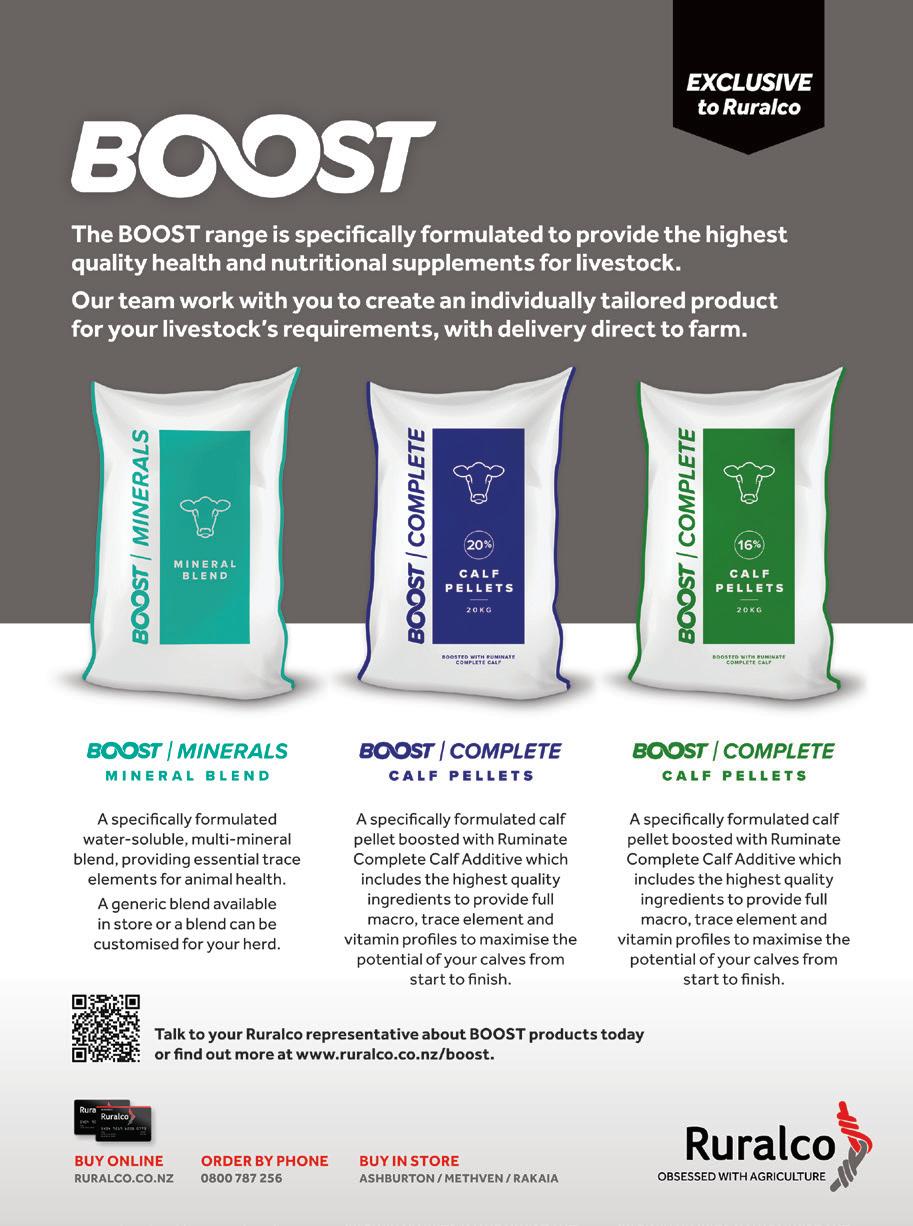

Home-grown pasture is your best friend when times are good. But when budgets are stretched, it truly comes into its own as a high value, high return asset.
Nothing else can match it in terms of costeffective feed. And the more you grow and harvest directly with your animals, the lower your costs of production for every kilogram of milk, meat or liveweight gain produced on your farm. Not all pasture seed is equal, however, some options are higher risk than others, so it really
pays to dig into these differences before you sow this spring. Pick the right proven performers for your situation, and you’ll consistently get the best possible outcome, not just straight away but in the medium term as well.
Short-term fixes have their place, but it’s important to balance these with longer term pastures to deliver the best returns.
Annual ryegrass sown this past autumn as a cost-saving measure, for example, was only an interim solution. After 6 to 12 months, when it runs out, those pastures will start going
IMAGE: A key goal in breeding Forge was to create a longer-lasting cultivar for farmers who wanted the benefits of a tetraploid with more persistence than other hybrids
backwards again without further renewal, which in turn means spending more money. It’s also important to recognise that uncertified seed, while cheap, is unlikely to deliver value for either red meat or dairy system. In fact, it might do the opposite. There is no knowing what it contains, or how it will perform.
Of all the potential choices available to you this spring, uncertified seed is the riskiest, for many reasons. It can introduce new and unwanted weeds, produce low yield or bring other issues associated with seed of unknown origin and quality.
At the other end of the spectrum, with least risk and highest lasting value, is certified seed of top proprietary perennial ryegrass like Array, Maxsyn, and 4front. There is no question their yield, quality, seasonal growth and performance will give the best return on every dollar spent on pasture renewal this spring. Quality, germination, purity and endophyte are guaranteed and the long-term value inherent in these advanced genetics has been demonstrated time and again.
We realise some farmers can’t afford to sow as many paddocks in these high-value perennials as they’d like this spring. If this sounds like you, value might best be achieved with a hybrid like Forge.
This will grow 1–1.5 tonnes more dry matter per ha through the cool season than a perennial for two to five years, with higher palatability for improved animal performance. It’s not a perennial and it will need to be replaced, but in the medium term, it will help your farmers get through the next few years with reliable, quality, cost-effective feed.
Pasture eaten remains a key driver of profit on farms, and when budgets are under pressure, pasture is critical to drive production. Even if it means renewing only one paddock really well, with proven pasture genetics, you’ll be better off in terms of value doing this than risking sowing multiple paddocks with uncertified seed this spring.
If you’d like to discuss this in more detail, talk to your local Ruralco team today. You’ll be glad you did!
THIS PROMOTIONAL FEATURE WAS PROVIDED BY BARENBRUG

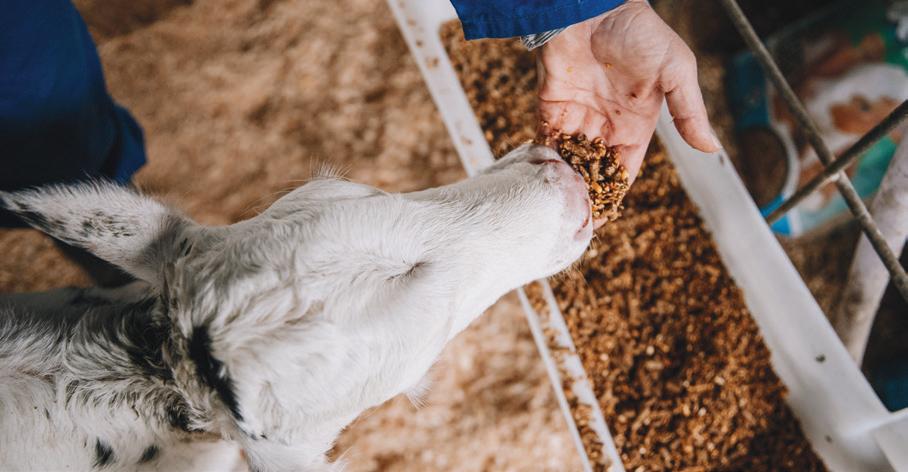
South Island dairy farmers have the perfect tool at their disposal this calving season to set their herds up for future productivity - the rumen in their replacement heifer calves.
Raising healthy replacement heifer calves that efficiently turn feed into milk is fundamental to the future of New Zealand’s dairy herd, says SealesWinslow Quality and Technical Manager Paul Drew.
“Farmers have a single fundamental tool at their disposal that can help them grow the most efficient dairy cows possible, and that’s the rumen in their replacement heifer calves,” says Paul.
The rumen is a vital part of a calf’s stomach, responsible for fermenting solid feeds and forages and turning them into usable energy. For a calf to thrive, its rumen needs to develop quickly and effectively. Paul says the key to achieving that is getting enough starch into their diets to kick-start the development of gut microbes.
“These microbes are essential for fermenting feed and producing volatile fatty acids, which are crucial for energy production.”
“Feeding a starch-rich diet from early on helps grow the calf’s rumen from a small, underdeveloped organ into a fully functional part of the stomach that can efficiently digest and absorb nutrients, enhancing the animal’s future milk production and profitability.”
Cows with fully developed rumen functions become feed-efficient machines, which supports initiatives like Fonterra’s Scope 3 emissions targets, aiming for a 30 percent reduction in onfarm emissions by 2030. Fonterra has signaled it expects to achieve 7% of that reduction through farming best practices, such as feed quality and improving herd performance.
“By focusing on starch-rich diets, farmers have a golden opportunity to rear replacements that become super-efficient at turning feed into milk, enhancing both production and profitability while contributing to the industry’s sustainability efforts,” says Paul.
Starch is a powerful energy source. The byproducts of starch fermentation in the gut, particularly volatile fatty acids, provide up to 75% of the energy needs of a fully developed cow.
“By feeding your calves high-starch feeds, you ensure they get the energy they need to grow strong and healthy,” says Paul.
Starch not only fuels growth but also enhances the structure of the rumen wall. The rumen wall needs to develop finger-like projections called papillae, which increase the surface area for nutrient absorption.
“Calves fed with starch-rich diets show significantly better development of these papillae, allowing them to absorb more nutrients
and grow faster, which all adds up to better efficiency,” says Paul
“Calves fed with high-quality feed with a good starch content reach target weights faster and reduce the overall amount of feed needed.”
“By incorporating starch-rich feeds into your calves’ diet, you help fire up the biggest tool you have to grow a more productive dairy herd.”
THIS PROMOTIONAL FEATURE WAS PROVIDED BY SEALESWINSLOW
TIPS TO GET THE MOST OUT OF STARCH IN YOUR CALF-REARING PROGRAMME:
Introduce Solid Feeds Early
Start with small amounts of high-starch feeds like a good quality calf pellet or muesli, alongside milk.
Choose High-Quality Feeds
Check the labels and look for feeds with a high starch content and avoid low-quality fillers.
Monitor Growth
Track your calves’ weight gain regularly to ensure they are growing at the desired rate and adjust the feeding programme accordingly.






AGRICHEMICALS ARE A MUCH-NEEDED TOOL FOR FARMING, AIDING IN THE GROWING AND PROTECTION OF FOOD PRODUCTION. FROM MANUFACTURE TO DISPOSAL OF AGRICHEMICALS, THERE ARE MANY CONTROLS FOR THE SAFETY OF PEOPLE, PROPERTY, AND PLACES.
It’s important you and your workers have the correct certifications for using hazardous substances, ensuring everyone knows the risks and how to protect themselves and others from harm.
Correct and proper use of agrichemicals in the workplace and environment is vital to ensure correct application and safety. It is also a legislative requirement. Certifications are required under the Environmental Protection Authority (EPA) when using agrichemicals that are toxic to the environment and toxic to the user (WorkSafe). Proof of certification must be provided but the question is: what type of certification do you need?
Certifications cover three areas: Controlled Substance Licence required for substances such as cyanide and animal and pest control; Certified Handler certificate for toxic agrichemicals for farmers/contractors; Qualified Person for ecotoxic for farmers/contractors. The certification you need depends on the agrichemical you use and store, as well as their classifications.
A Certified Handler is certified to handle toxic products classified as Category 1 6.1A and Category 2 6.1B Acutely Toxic. If you are buying, storing, or using Category 1 & 2 Acutely Toxic agrichemicals, which are Tracked Substances, you are required to have a Certified Handlers Certificate. Examples of common products needing a Certified Handler include Paraquat, Formalin, Bravo, Weatherstick – note these are only a few examples, always check the Safety Data Sheet or the label on products you are using.
Certified Handler Certificates are issued by Compliance Certifiers and are valid for five years. To become a Certifier Handler, you will need to demonstrate the knowledge, experience, and competence to safely handle the hazardous substances that your certificate will cover, as well as providing evidence of competence. Adroit Solutions can provide the full certification process online. This online process includes reading training material, completing and passing an assessment, and providing evidence of workplace compliance.
We often get asked: Can I renew my Certified Handler Certificate? Yes, these need to be renewed every five years. If your Compliance Certificate has expired, you cannot purchase hazardous substances that require a Certified Handler or continue to work as a Certified Handler.
In 2017, WorkSafe reviewed hazardous substances in the workplace, and products no longer requiring the Certified
Handler Certificate now fall under the less stringent Qualified Person certification.
A Qualified Person certificate under the EPA legislation is required when applying agrichemicals by motorised boom or motorised handspray gun. These agrichemicals are classified as Category 3 – 6.1C Toxic, Category 1 - 8.2A Corrosive, Category 3 – Class 9 Ecotoxic.
Our online Envirospray courses meet the requirement of EPA ‘Qualified Person’ Certificate and are called Envirospray Hand Pump Sprayer Course (Low Volume Use) and Envirospray Motorised Boom and Handgun Course (Large Volume Use). These courses are designed to be practical and informative to aid participants in upskilling and competently applying agrichemicals from tank to target.
This training is for applicators using motorised boom, handgun, or where spray could go off target. It’s online process also includes reading training material, completing and passing an assessment, and providing practical evidence photos before the certificate can be issued. These certifications also have a life span of five years.
Adroit Solutions Ltd is a training provider that provides advice and training courses to help workplaces and businesses selling, storing, using or disposing of agrichemicals. All our training is designed to ensure users become skilled in protecting people, property, and places.
You can find us online at www.adroitsolutions.co.nz .
THIS PROMOTIONAL FEATURE WAS PROVIDED BY ADROIT SOLUTIONS



WHETHER IT’S EXTREME WEATHER EVENTS OR CHANGING REGULATIONS, DEALING WITH UNCERTAINTY IS A CONSTANT FOR MANY FARMERS AND GROWERS. HERE ARE FARMSTRONG AMBASSADOR SAM WHITELOCK’S TIPS FOR NAVIGATING TOUGH TIMES.
Sam Whitelock comes from a farming background and will return, to farming once he’s back in the country. As a professional athlete he’s also had plenty of experience at handling pressure and setbacks. Here are a few of his insights:
KEEP IT SIMPLE
“I think the best players I’ve seen at handling pressure are the ones who focus on doing the basics really well game after game, irrespective of the weather, the ref, or pressure on the scoreboard. When I’m under pressure, I try and keep it simple and just concentrate on the things I’m good at and can control.”
Prioritise
“Work on a farm is never done, so it’s important to prioritise. Work out what you can and can’t do in a day and be okay with that. Ask yourself ‘what are the top two or three tasks I need to do?’ and park everything else. Once you’re feeling back in charge, your stress levels will go down.”
KEEP TALKING
“Pressure is pressure whether you’re a grower, a farmer, or a rugby player. I know from my own experience that talking through these challenges with mates and family helps enormously.”
“If you see someone struggling, start that conversation, ask them how they’re going, and make time for a proper catch-up, whether it’s over a coffee or at the pub. You don’t have to have all the answers; just listening can be a huge help to someone who is feeling ‘under the pump’.”
TAP INTO LOCAL KNOWLEDGE
“One of the best things I’ve learned is to listen to people who have been through similar experiences before. There’s a lot of knowledge in your community from people who’ve faced droughts, floods, or other adverse events and come through okay. Make sure you tap into their wisdom and advice.”
RETAIN PERSPECTIVE
“Rugby is a big part of my life, but I also have other things going on, so it doesn’t define who I am as a person. The expectation is always there that we will win every game, but that’s not the reality. So, while losing a rugby game still hurts, I remind myself that I’m still a father, a husband, a son with a great family. The reality is I also have other aspects to my life, so it doesn’t define who I am as a person.”
GIVE YOURSELF A BREATHER
go hunting with mates to relax, unwind, and forget about rugby. Time away from your main job energises you for when you are back at work. “
“These simple habits help keep things in perspective when the going gets tough: staying connected with mates; keeping active; taking note of and enjoying the simple things in life; learning new things to keep fresh; giving back to friends and
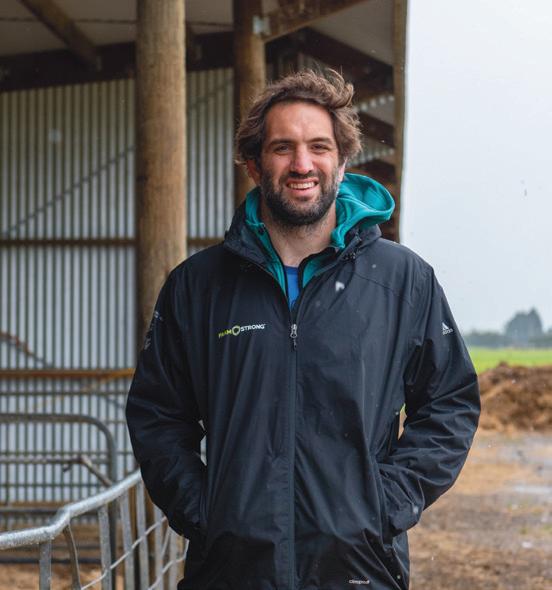
“No-one can just go ‘hammer-down’ all the time. We all need time to ‘reset’ physically and mentally, even if it’s just for a short while at smoko or lunch. One of the things I’m doing now is planning a ten-minute slot each day and saying, ‘this is my time’. I know taking breaks when you’re busy sounds odd, but I’ve learnt it makes you a lot more efficient and productive in the long run. You’re not tired and overthinking things.”
PLAN BREAKS
“If you’re only thinking about one thing, such as the weather, all day, every day, it will start to get on top of you. So, it’s important to go and do something else from time to time. I play rugby because I love it, but I also
“Farming, like professional rugby, is a job with a lot of challenges. That’s why it’s important to look after yourself by investing in your wellbeing. I’ve found the Five Ways have a positive, cumulative effect over time. They make you more resilient and give you something to draw on when you are under pressure. Different things work for different people, so find out what works for you and ‘lock it in’.”
Farmstrong is a rural wellbeing programme that aims to help farmers and farming families live well to farm well. To find out what works for you and “lock it in”, check out our farmer-to-farmer videos, stories and tips on www.farmstrong.co.nz.
AT 54 YEARS OLD, RURALCO ON-FARM SALES MANAGER, LESTER CHAMBERS IS PRETTY OPEN ABOUT HIS EXPERIENCE WITH PROSTATE CANCER.
Lester could have easily fallen within the margin of men who would rather not talk at all than talk about the issues they’re having “down there”. But instead, Lester understands the importance of openly sharing his experience with a disease that kills roughly two Kiwi men every day.
When Lester was in his late 30’s, he received a call. His father, Ron, had been in a car crash and was being airlifted to hospital. It was there that doctors disclosed Ron was in renal failure as a result of progressive prostate cancer. Lester’s father knew about the cancer, but he had been silently suffering with it for years. By the time his family found out it was already too late. A month later, at 65 years old, he was gone.
After his father’s death, Lester took it upon himself to educate himself about the disease. He realised that, with his father’s history, the chances of him also getting prostate cancer increased significantly and he needed to do something to mitigate the risk.
“Because I knew my father had died of it, probably every year or every two years I was getting tested,” says Lester. “Even though I had a family history of it, there was no system in place to remind me to get tested, other than my own volition. And there should be.”
The initial test for prostate cancer is a simple blood draw that checks PSA (prostate-specific-antigen) levels. “There’s no fingers, it’s not invasive,” Lester says.
In August 2021, the blood test that had become routine for Lester came back showing elevated levels of PSA, a common indicator that something is abnormal. Doctors monitored the levels through a further blood test in October, but they didn’t decrease. “They decided it would be best to get a biopsy done,” Lester recalls.
WORDS
BY INDIANA ROBERTS, IMAGE BY ANNIE STUDHOLME
“I would not have known there was anything wrong. I had no idea I was living with something that could potentially kill me.”
The two treatments that he had access to were surgery or radiation therapy, but at the time radiation therapy felt like the best option for him. “Something to note is that if you get prostate cancer and get treatment for it, you will not be able to father children anymore. But at my age that wasn’t a concern.”
Lester has three adult children and five grandchildren. He lives in Ashburton with his wife, Lisa, and loves getting away in the caravan and visiting family.
In May 2022 Lester underwent a month of radiation treatment and further blood tests to monitor the PSA levels once more. In December 2022 doctor’s officially informed Lester he was in remission.
“A lot of men don’t talk about it,” Lester says. “But for me, with my experience, I sit here and wonder why would you not? If you know it’s an issue or there’s potential for an issue, why would you not just get a blood test?

LesterChambers
He booked in for a physical exam, and in February 2022 was referred to a urologist where the biopsy was completed, and 12 samples were collected from his prostate gland. Around the end of February 2022, Lester heard back about the biopsy results. “They phoned me and said that one of the samples had come back with cancer…malignant cancer.”
“I had not had any issues. If you were to take me physically at the time, other than the PSA test and the biopsy, I had no symptoms. Nothing. Zip. I would not have known that there was anything wrong. I had no idea I was living with something that could potentially kill me.”
Lester was confronted with the reality that, without treatment, this disease he wasn’t even aware he had could progress to be fatal. He was not going to go out like his father had – it was time to make a plan.
“When you have a life-threatening disease you do a lot of research,” Lester says. “It was a pretty tough time mentally; it does knock you around when someone says, “you’ve got cancer”.”
“I’m back to normal, back to 100%. You wouldn’t even know that I’ve had treatment. But if the doctors hadn’t caught it as early as they had, I might not be sitting here today. Prostate cancer doesn’t always present with symptoms, so get it added to a blood test when you next go to the GP.”
Prostate cancer is the most commonly diagnosed cancer in New Zealand with around 4,000 diagnosed every year [exceeding breast cancer levels], that’s an average of 10 every day.
• Prostate cancer is the second highest cause of cancer death in men after lung cancer, and the third highest for all sexes (behind lung and bowel cancers).
• 1 in 8 men will develop prostate cancer in their lifetime.
• Around 700 Kiwi men die from prostate cancer each year, that’s almost 2 men every day.
• An estimated 42,000 men diagnosed with prostate cancer are living in New Zealand.
• Māori men are 72 per cent more likely to die of prostate cancer once they are diagnosed than non-Māori men.
• 61% of prostate cancer survivors say they had no symptoms when diagnosed.
• Prostate cancer is a family issue—if a man has two or more firstdegree relatives who were diagnosed with prostate cancer under the age of 65 years, then his risk increases by 5–11 times.

Contact the Prostate Cancer Foundation Information Service. Dial 0800 66 0800 toll free from anywhere in New Zealand, Monday to Friday (10:00am to 6:00pm)
OCTOBER IS BREAST CANCER AWARENESS MONTH

ABOUT 70–75% OF WOMEN WHO ARE DIAGNOSED WITH BREAST CANCER AND ABOUT 80% OF WOMEN WHO DIE FROM IT ARE AGED 50 YEARS OR OLDER.
Some women are at greater risk of breast cancer because there is a history of close family members having the disease. However, most women who develop breast cancer have no relatives with the disease. Even among women who do have relatives with breast cancer, most will never develop it.
While it is less common, young women can get breast cancer too. 6% of breast cancer in New Zealand occurs under the age of 40 years. Although it is uncommon, men also get breast cancer. About 25 men are diagnosed in New Zealand each year.
Nine New Zealand women, on average, will hear the news today that they have breast cancer.
CHECKED YOUR BREASTS LATELY?
Breast cancer is most treatable when it’s found early. From age 20, it’s important to know the look and feel of your breasts, and show any changes to your doctor. From age 40, we recommend you start regular
mammograms.Checking your breasts is easy as TLC. ‘Know your normal’, so you can find any changes in your breasts as soon as they appear.
• TOUCH
Touch both breasts. You’re feeling for any lumps or thickening of the tissue, even up into the armpits.
• LOOK Look in front of a mirror. Can you see any physical changes to the breast shape, skin or nipples?
• CHECK
Check any breast changes with your doctor. Even if you’ve had a mammogram recently.
Contact the Breast Cancer Foundation NZ. Phone 09 304 0766 or dial 0800 902 732 toll free. You can also email info@bcf.org.nz.






LABOUR DAY
28 OCTOBER 2024
ASHBURTON A&P SHOW
1–2 NOVEMBER 2024
If you’re in the area come see us at the Ashburton A&P show where you can talk to us, grab a bite, and enjoy the approaching summer weather.
CANTERBURY ANNIVERSARY 15 NOVEMBER 2024
RURALCO LONGBEACH COASTAL CHALLENGE 24 NOVEMBER 2024
Take part in this coastal challenge event, a great day out with family or friends and various events available whether you bike, run or walk. Sign up today at longbeachcoastalchallenge.com
ASHBURTON:
Monday to Friday: 8:00am–5:30pm Saturday: 9:00am–12:00 noon Closed on public holidays & Saturdays when the public holiday falls on a Monday or Friday.
RAKAIA:
Monday to Friday: 8:00am–5:30pm Closed on public holidays.
METHVEN:
Monday to Friday: 8:00am - 5:30pm Closed on public holidays.
STORE CLOSURES:
LABOUR DAY
28 OCTOBER 2024
Our Ashburton, Methven, and Rakaia stores will be closed on Saturday 26 and Monday 28 for Labour Day. All stores will be returning to business as usual on Tuesday 29 October.
CANTERBURY ANNIVERSARY
15 NOVEMBER 2024
Our Ashburton, Methven, and Rakaia stores will be closed on Friday 15 and Saturday 16 November for Canterbury Anniversary. All stores will be returning to business as usual on Monday 18 November.
Win $500 for a school of your choice!
We’re local first. That means we’re making sure we give back to our local communities and future farmers.
Our Spend for Your School programme offers you the chance to win $500 for a primary school of your choice. Simply spend with businesses that accept the Ruralco Credit Card and go in the draw to win*. Plus, you get great discounts and real value when you choose to use your Ruralco Credit Card. Find out more by visiting www.ruralco.co.nz/spend-for-your-school. Terms and conditions apply.

Congratulations to our winning primary schools, Wakanui and Mayfield, who received $500.00 after being nominated for our Spend for Your School cash prize in June and July.
Agronomy Guide out now
Check out our 2024 Agronomy Guide with details of the latest seed varieties across fodder beet, brassicas, grasses, pasture and catch crops at ruralco.co.nz/agronomy.

Looking for the perfect gift for birthdays, weddings, or anniversaries this Spring?
Choose from our wide range of quality brands and get the perfect gift, in store or online, delivered direct to you.
Shop our range:

• Beautiful linens and throws for the bedroom, bathroom, and living rooms;
• Home decor;
• Quality kitchenware and bakeware;
• Cuisinart mixers and small appliances;
• Silverware, glassware and serveware;
• Home and garden accessories.
Save 12¢ on fuel with your Ruralco Credit Card
Fill up with your Ruralco Credit Card at selected Mobil and Allied fuel sites across the country and save at least 12¢ per litre off the pump price. Find fuel sites near you at ruralco.co.nz

Kim Wright returns to Ruralco
Kim Wright has returned to Ruralco as an On-Farm Account Manager, bringing a wealth of experience and a deep passion for agriculture to our co-operative. Specialising in dairy, she focuses on animal health and nutrition, ensuring her customers receive tailored solutions to meet their unique needs.
With 17 years in the agriculture sector, Kim has nine years’ experience working on a dairy farm, providing her with invaluable insights into the daily operations and challenges faced by dairy farmers. She spent six years at SealesWinslow, where she gained her expertise in animal nutrition.

A lifelong resident of Ashburton, Kim values the close-knit community feel at Ruralco. “Returning to Ruralco felt like coming home to family,” she says. “Everyone here is supportive, and we truly care about our community.”
Kim appreciates Ruralco’s transparent, farmer-built structure, which aligns with her commitment to honesty and integrity.
What Kim enjoys most about her job is being out on farms, understanding the diverse processes, and providing tailored solutions for farmers. Her future aspirations are to expand her knowledge of arable farming to provide even more comprehensive support to her customers.
Friendly, approachable, and dedicated to finding the right solutions, Kim is a trusted partner for local farmers. We are proud to have Kim with us at Ruralco, where her experience and dedication greatly benefit our team and the community.
Have you tried BOOST Mineral Blend?
Our BOOST Mineral Blend is a specifically formulated watersoluble, multi-mineral blend providing essential trace elements for animal health. We can customise the mix to suit your dairy herd’s requirements, delivering it direct to farm.
Talk to your Ruralco Representative today to discuss the best mineral mix for your livestock or find out more online at www. ruralco.co.nz/boost
Maximise calf health and growth with our premium feeding solution!
Looking to boost your calves’ growth and health? Our BOOST Calf Pellets paired with Ngahiwi Calf Milk Replacer is the perfect solution. From day one, this combination provides comprehensive nutritional support for stronger immunity and rapid growth:
• Smooth transition to solid feed;
• Robust rumen development;
• Enhanced immune function.
These products work together seamlessly, ensuring your calves grow healthier and faster. Want to give it a try? Just contact your OnFarm Representative or our friendly customer service team to order our premium nutrition combo today!
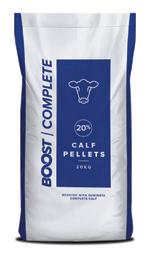

Ruralco and Ballance are here to help you grow the future of your farm
Our partnership with Ballance Agri- Nutrients gives you access to local fertiliser experts that can tailor a solid fertiliser plan to maximise your on-farm production potential. Together we can bring you science-backed and innovative nutrient solutions that will maximise your onfarm production potential delivering a measurable return on investment.
Make the switch to Ballance through Ruralco for all your fertiliser requirements. Talk to your Ruralco Representative today.
Through our suppliers, Ruralco can design and implement a solar system for your business, enabling you to beat rising energy costs, offset emissions, and make better use of a natural resource to produce and store renewable energy. Not only can solar power be used for powering irrigators and dairy sheds— it can also be used to offset the cost of lighting, heating and ventilation in farm buildings and homes.
Talk to the Ruralco team today on 0800 787 256 to find out how we can help introduce solar to your business.


This is just a snapshot of the many great businesses where you can use your Ruralco Credit Card and save. Visit www.ruralco.co.nz for a full list of participating businesses near you and discounts available.
When you run a farming business, there’s no time for standing still
Which is why you need easy, reliable access to fuel, at competitive prices, for all the equipment that drives your farm every day. Our team are here to ensure all your fuel needs are covered. Through our partners, we offer a large range of fuel storage tanks for purchase or lease. We make it as convenient as possible, with fuel delivered direct to your door. Not only that, Ruralco members benefit from bulk fuel pricing, so you’re always getting the best possible price. Contact us today to find out more.

















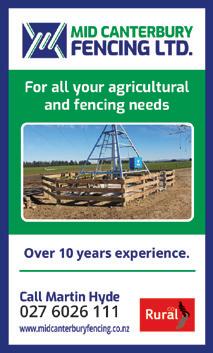

















WE’RE CANTERBURY BORN AND BRED. OUR BUSINESS WAS FOUNDED IN 1963 BY LOCAL FARMERS, WHO WANTED CHANGE AND FOUND THE SOLUTIONS.
Since then, we’ve achieved a lot together and our vision remains the same. Our core purpose is offering real value with the latest innovation in farm supplies, services, and expert advice to keep your farming business thriving for generations. In Mid Canterbury, the heart of our homeland, we remain here for you, our farmers. Our people live in your rural communities so, it’s in our best interest to get it right for your farming business.
Our obsession is agriculture, but our focus is you.

